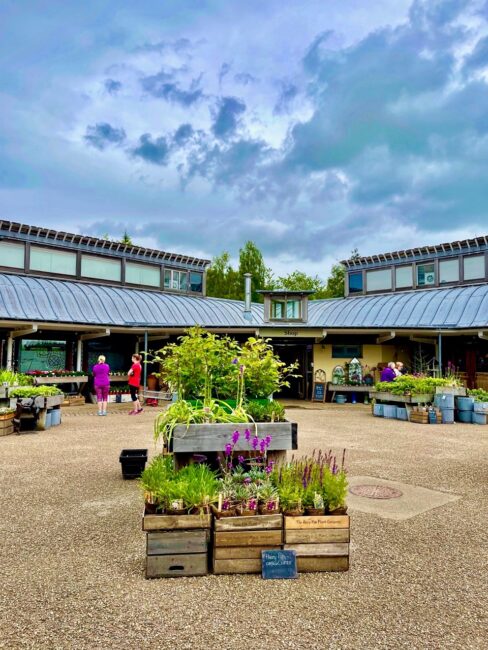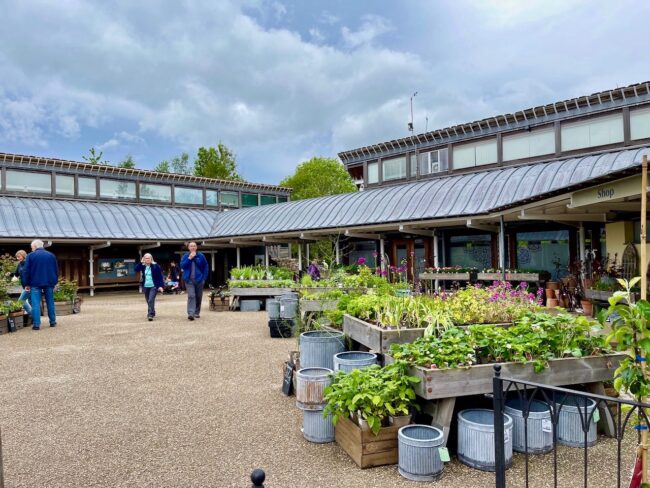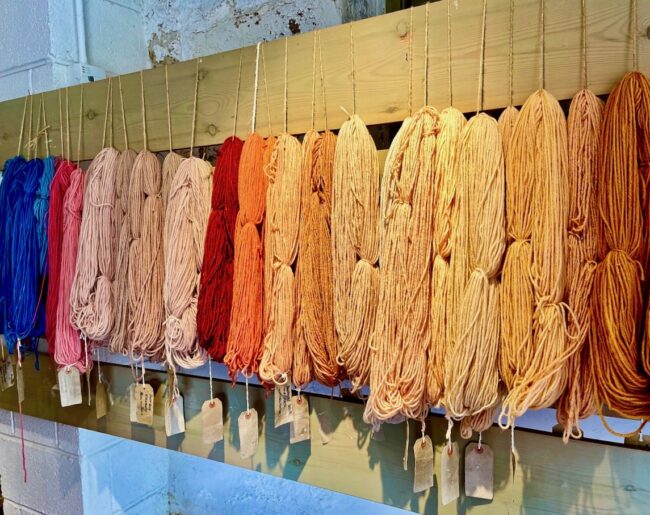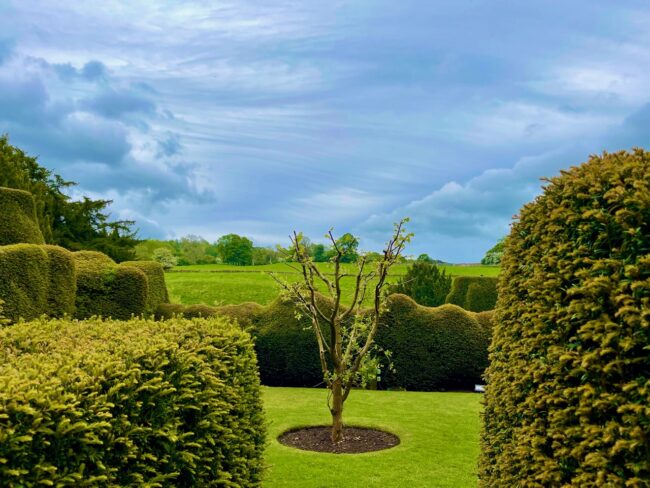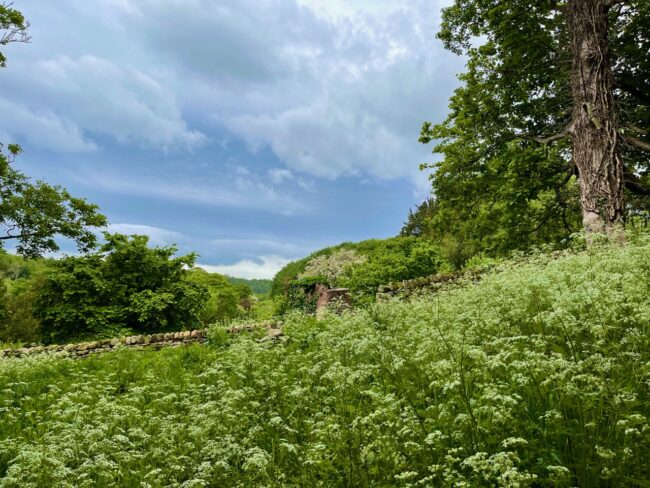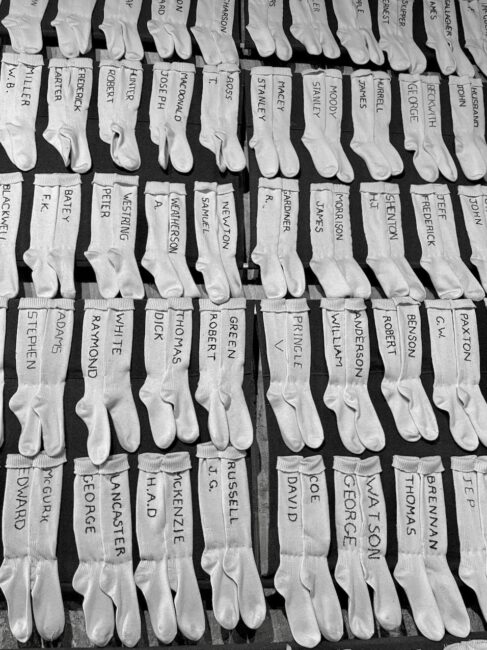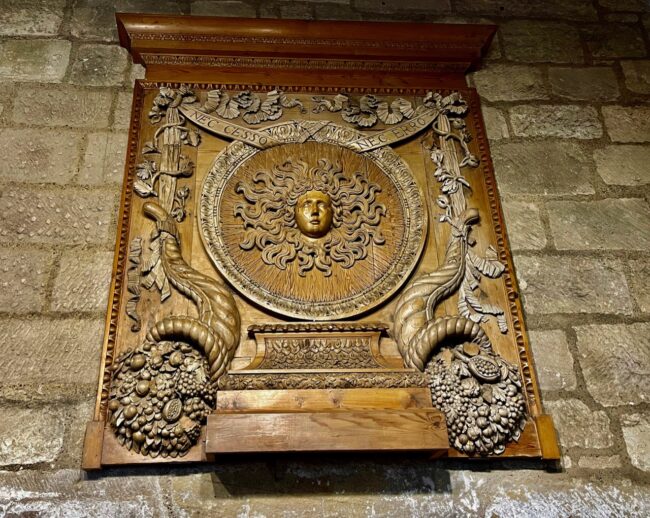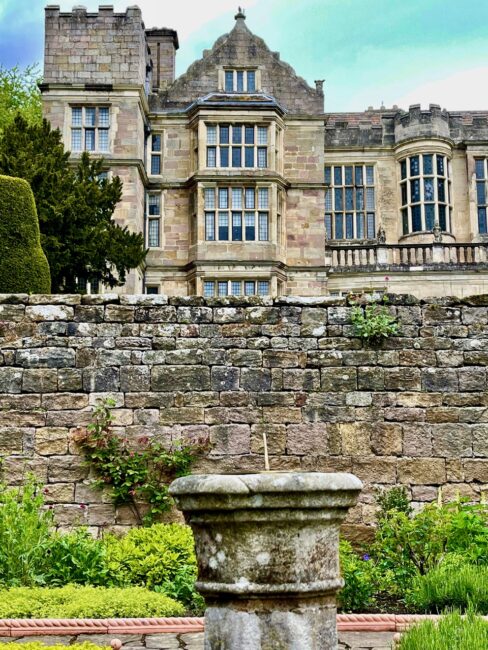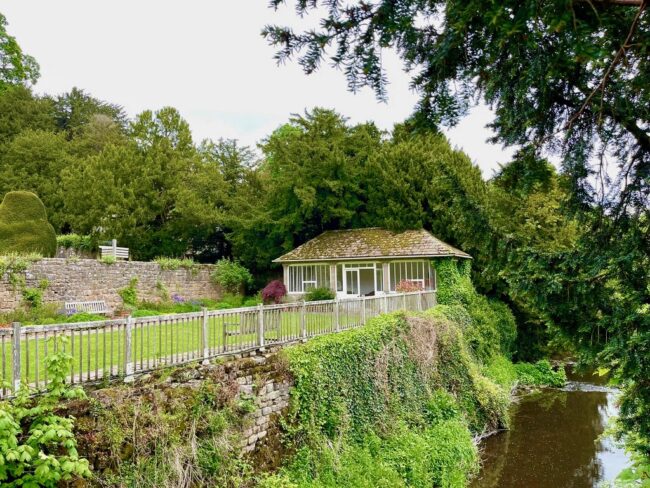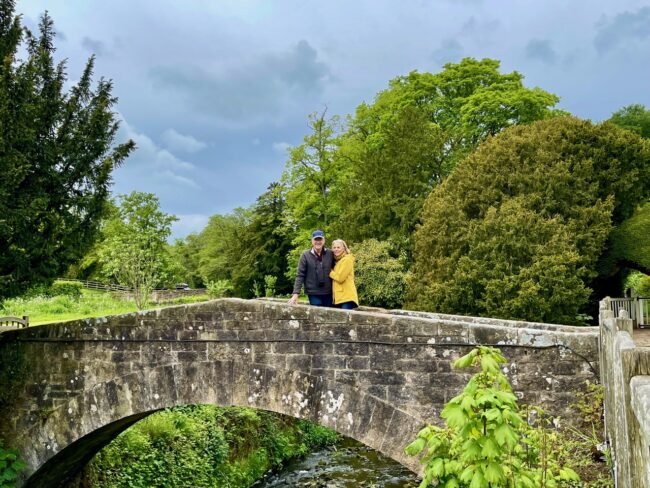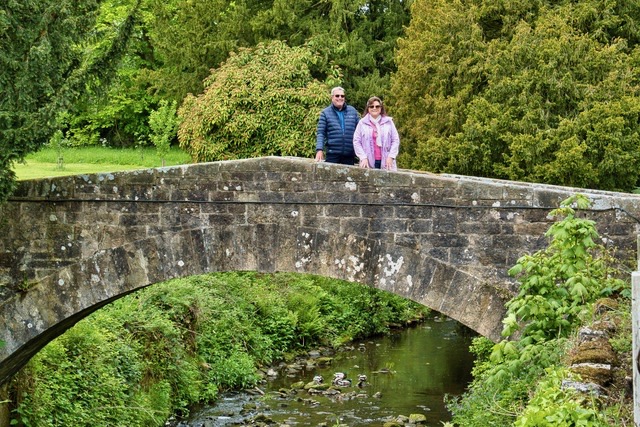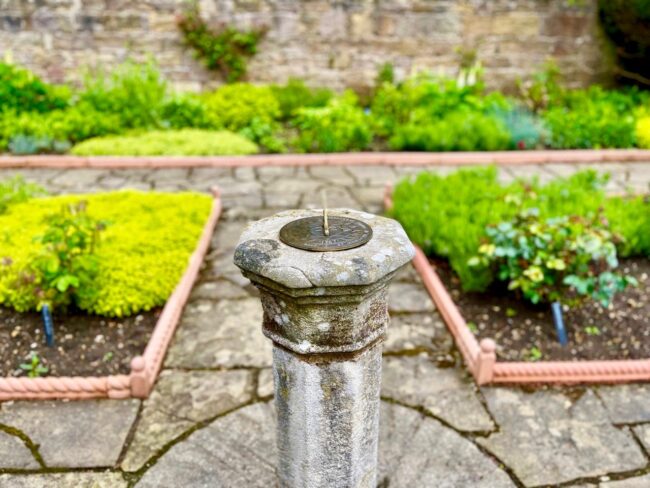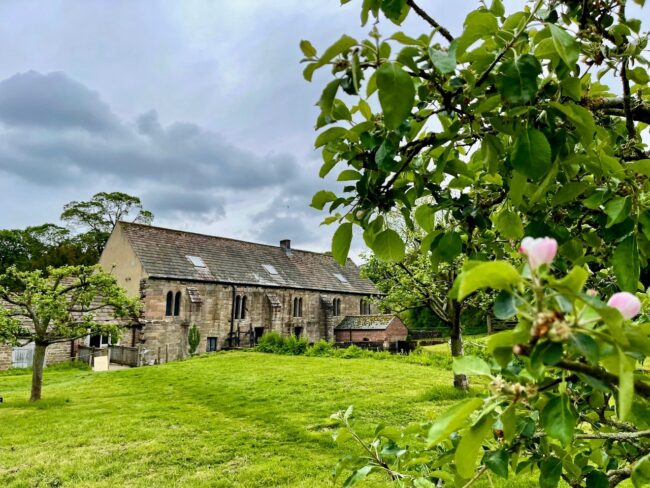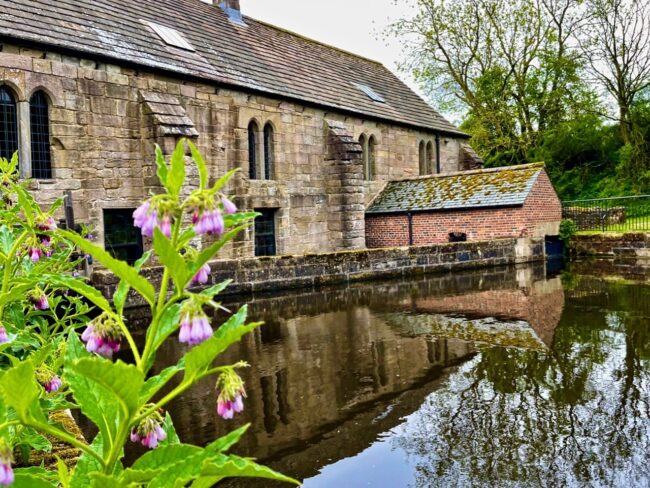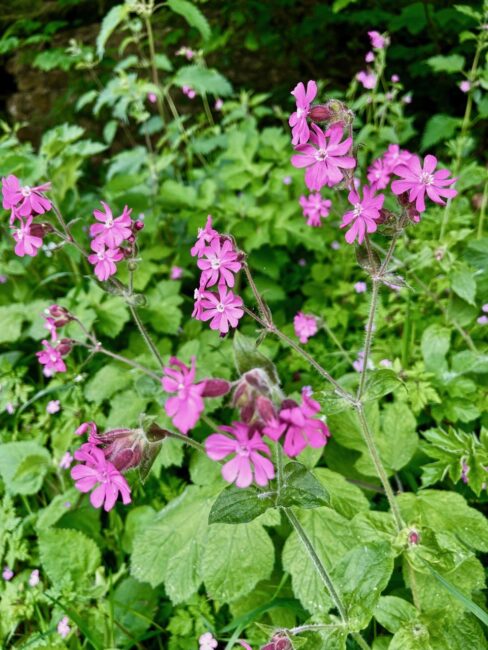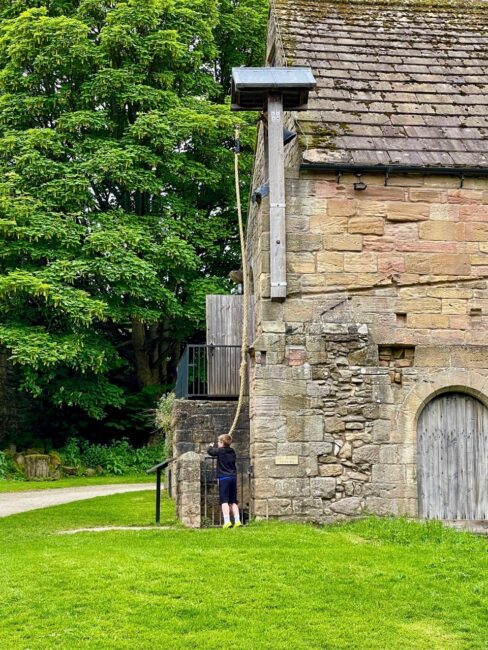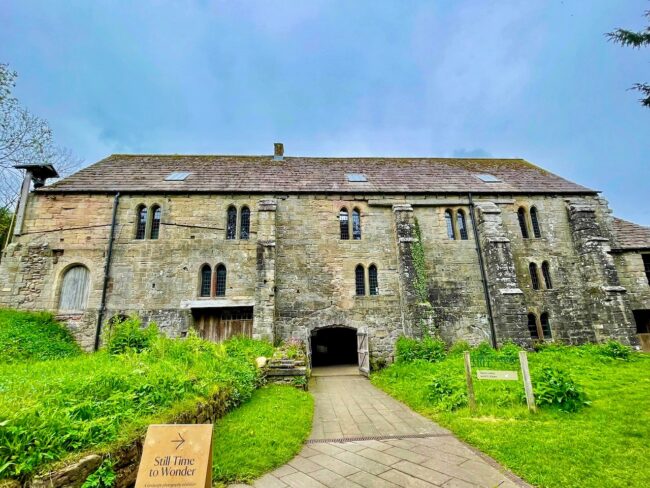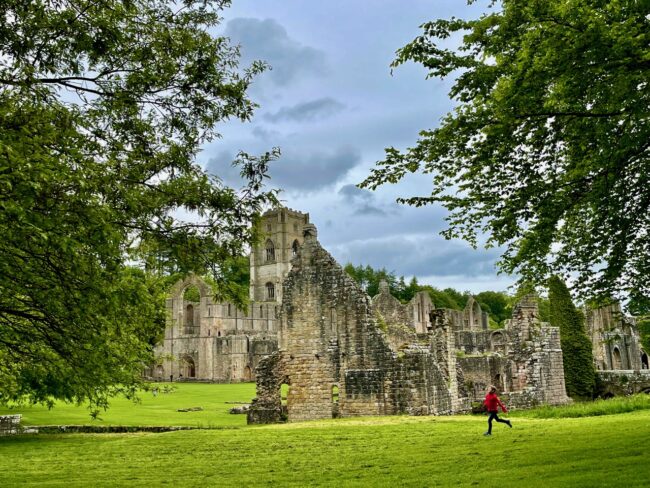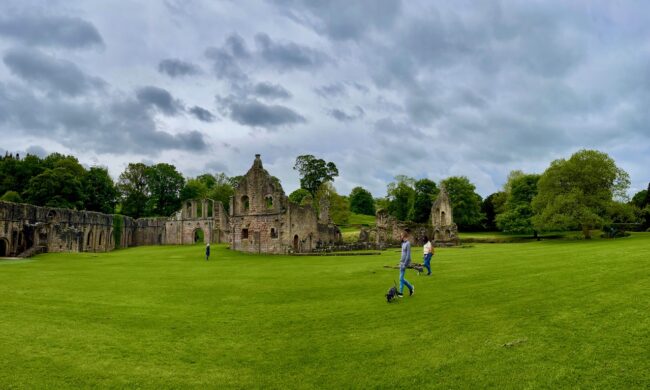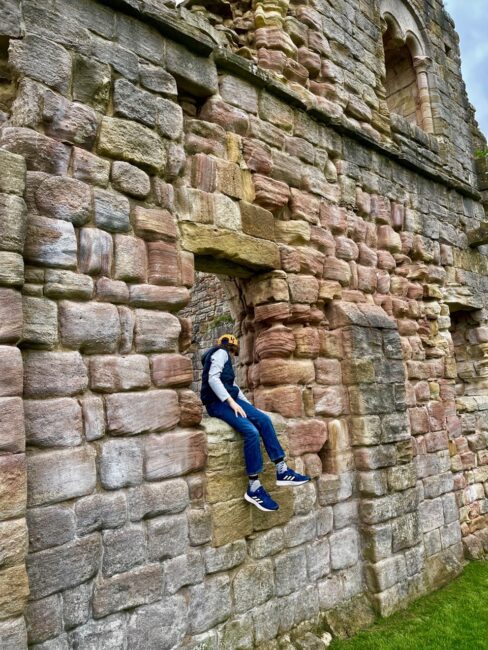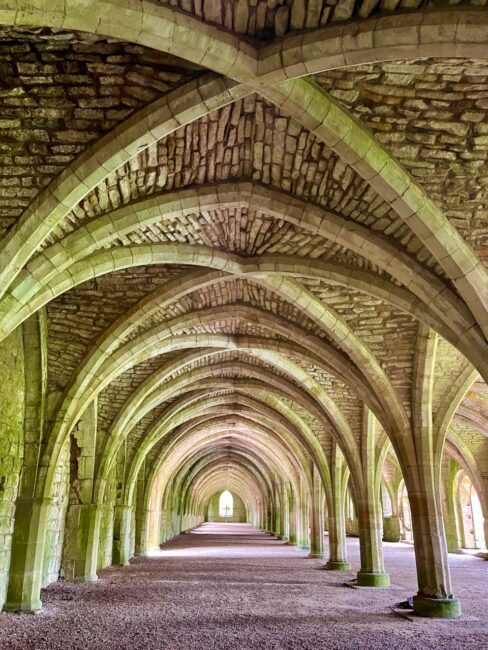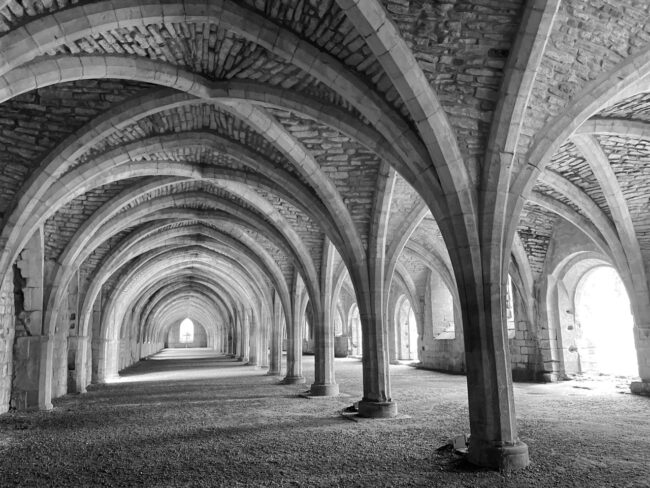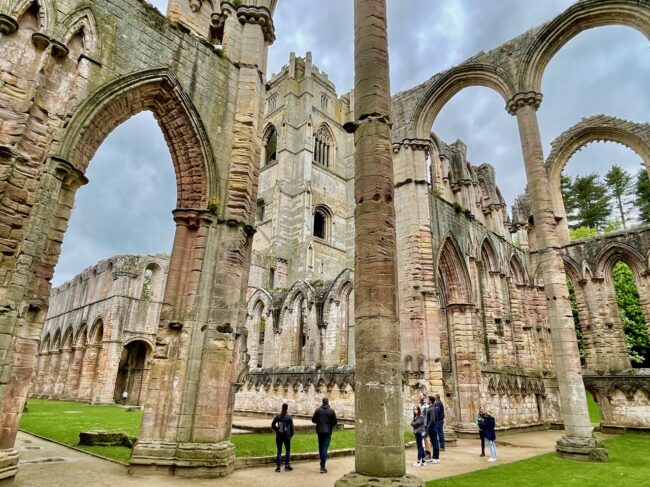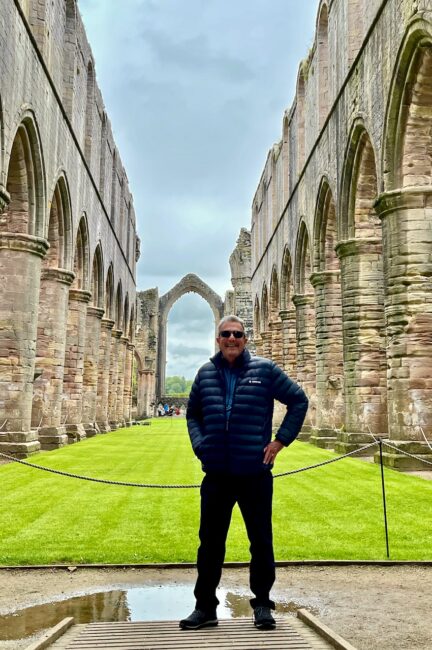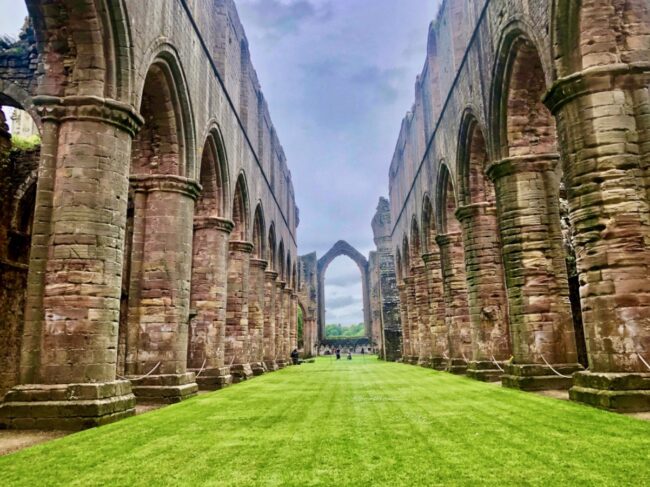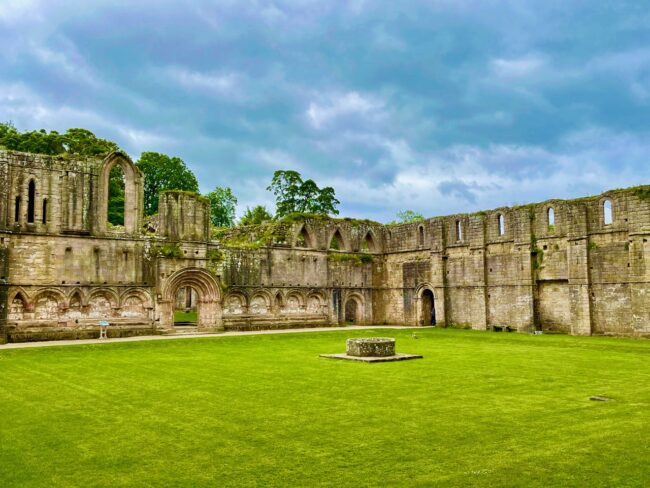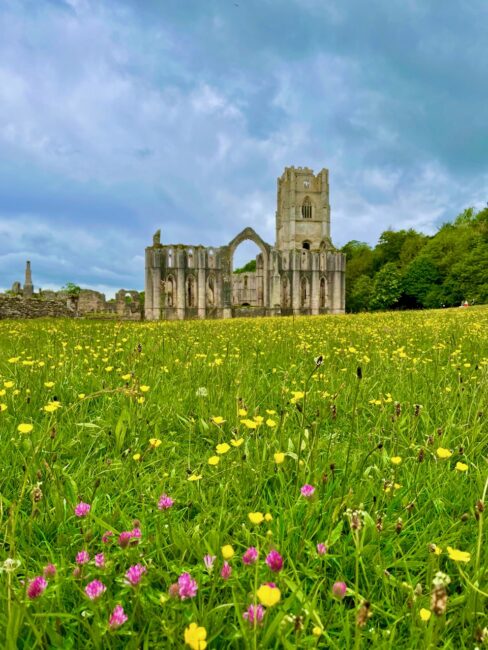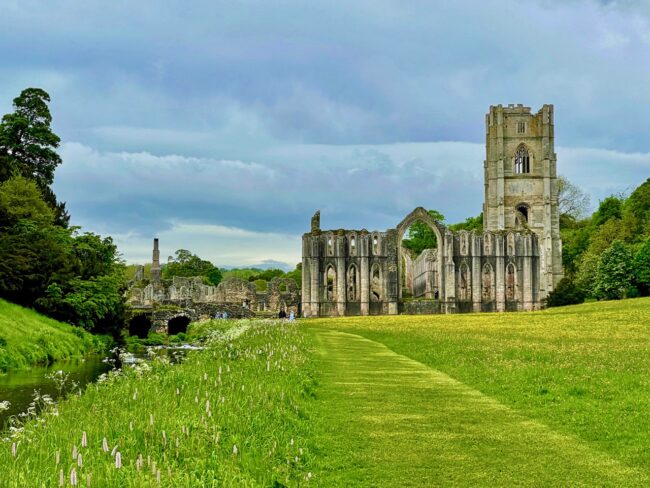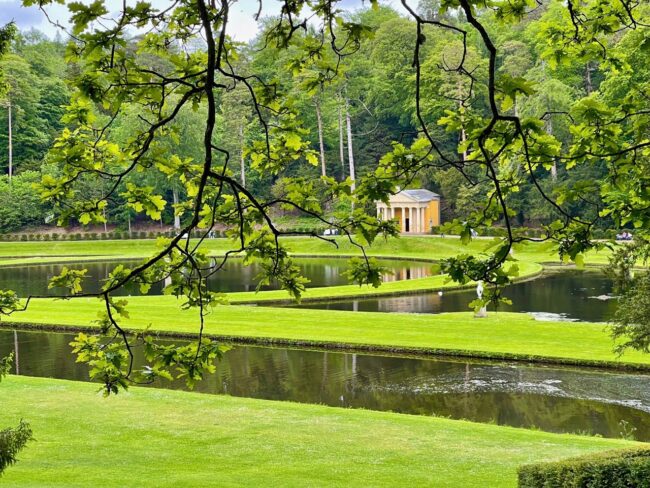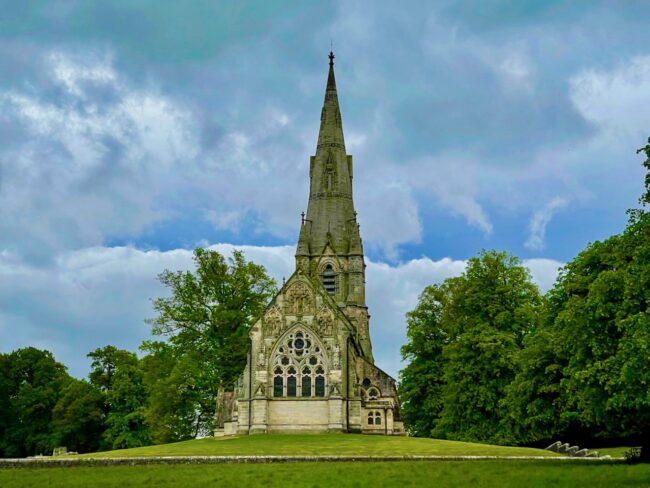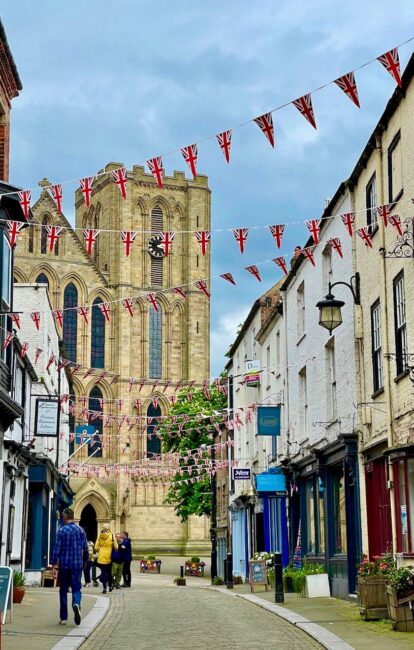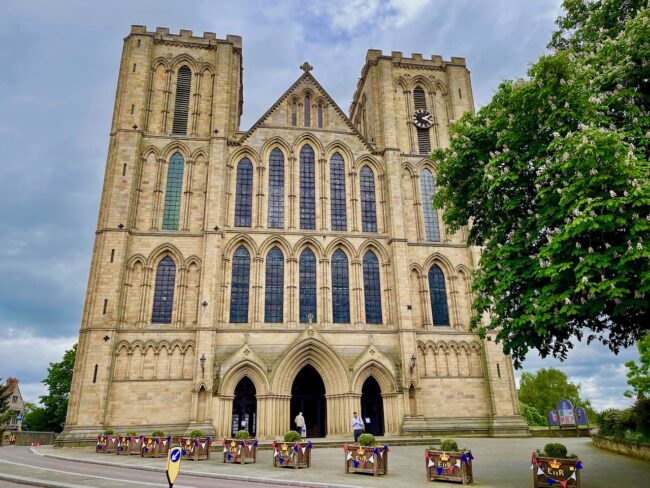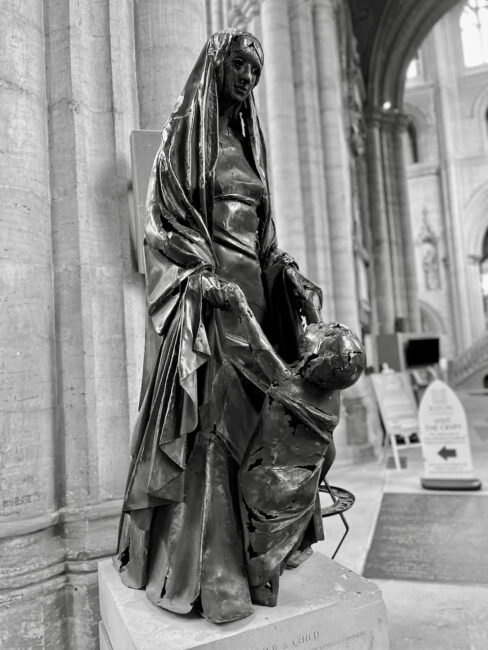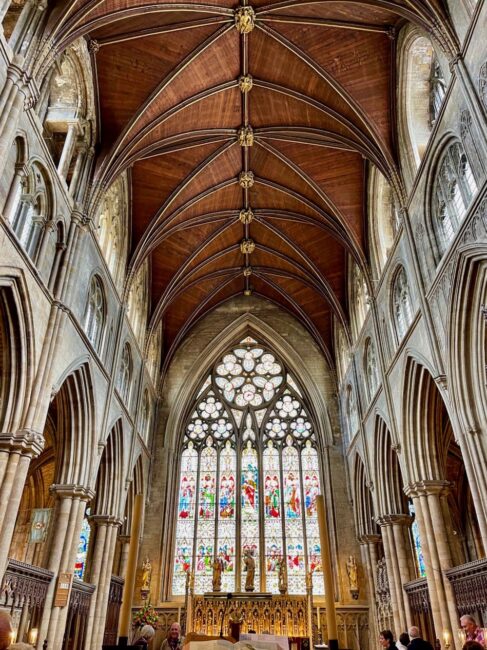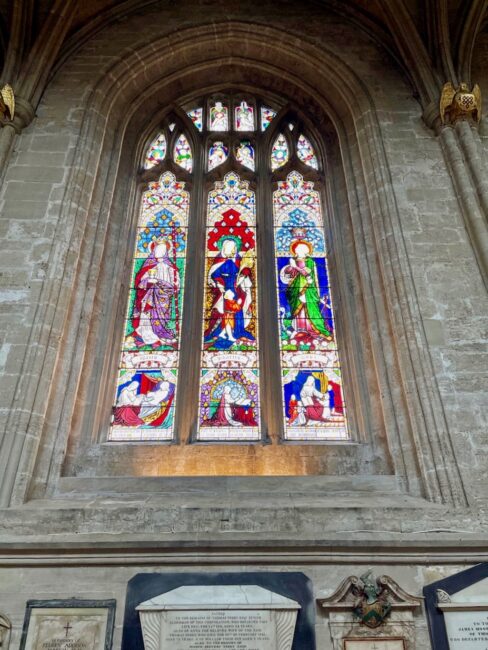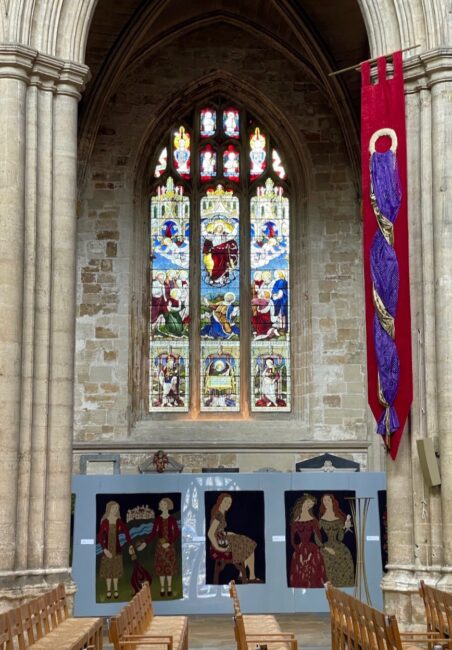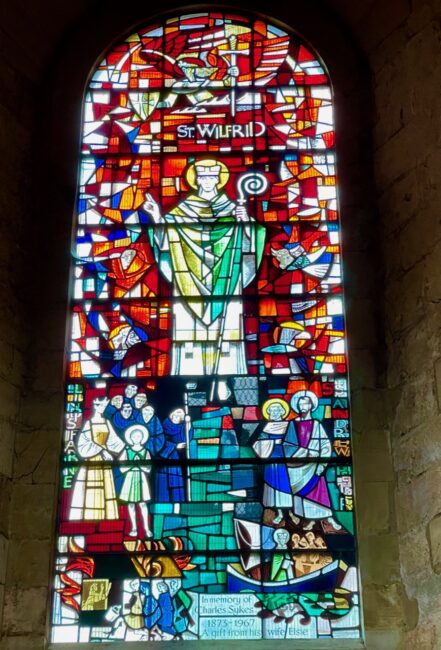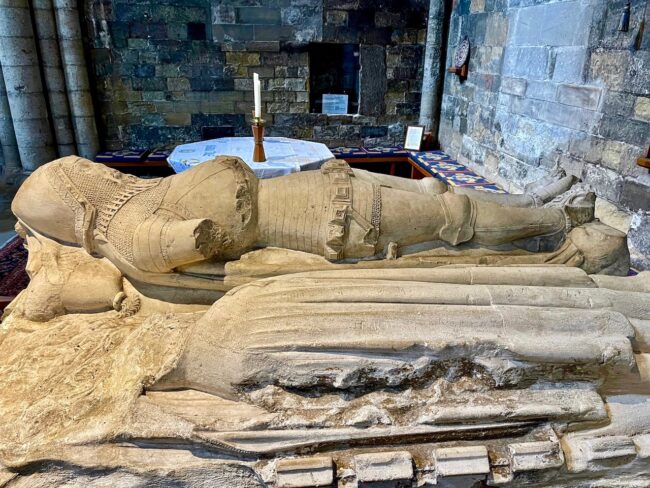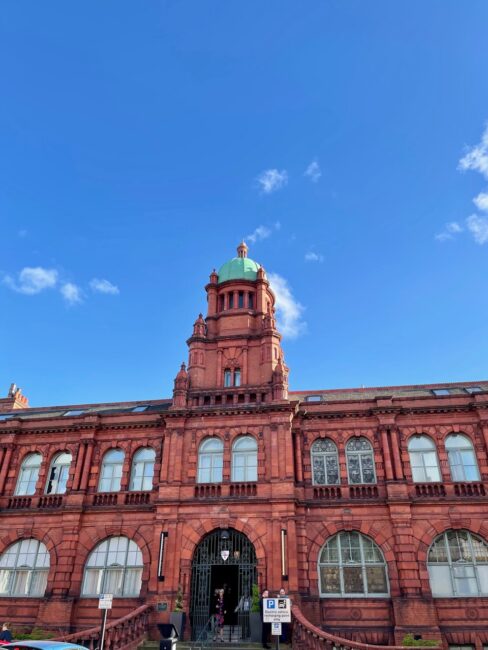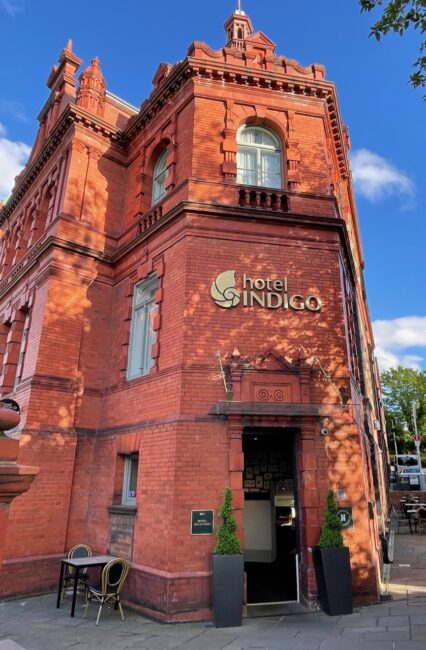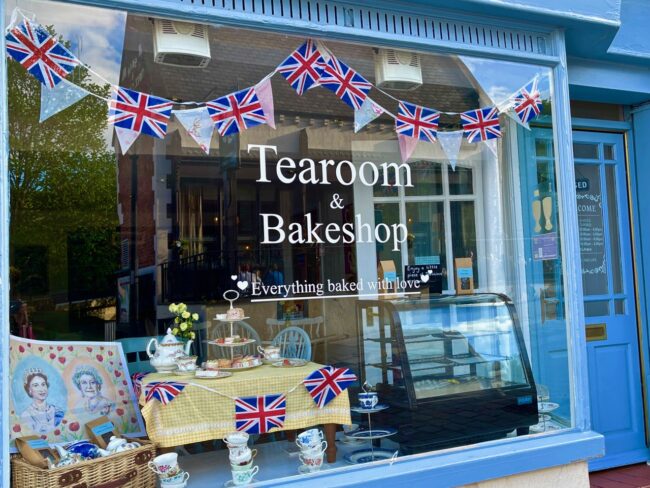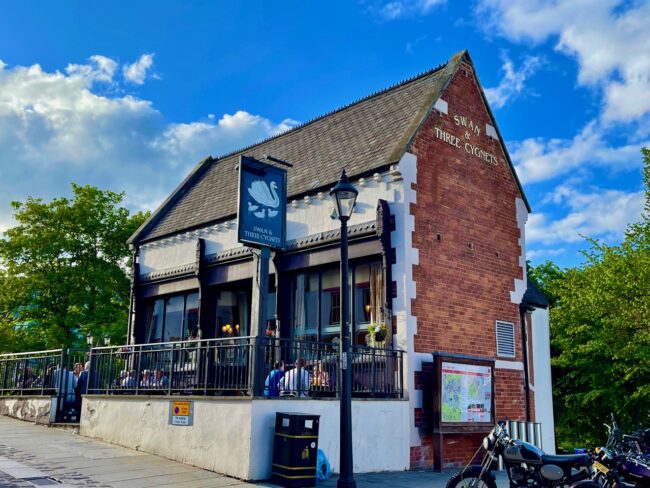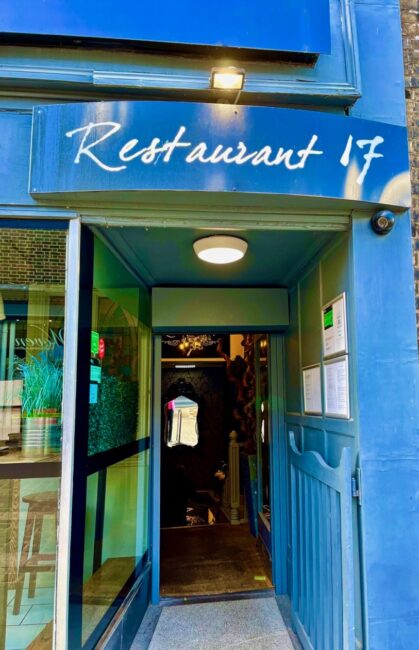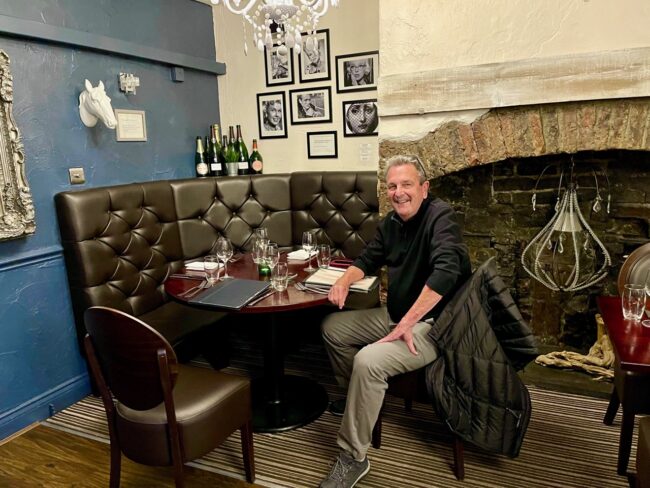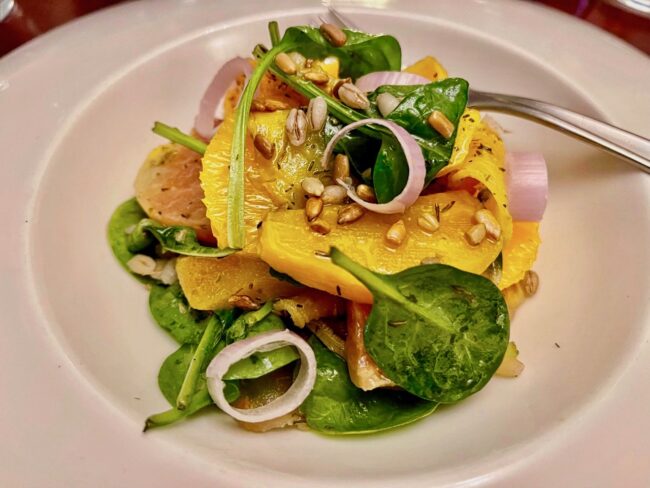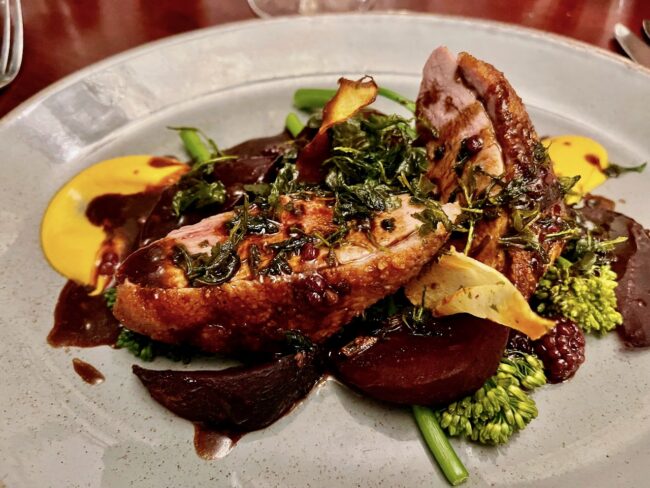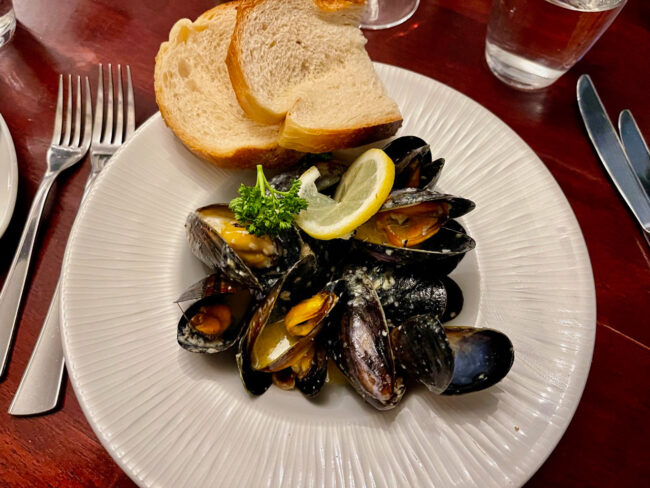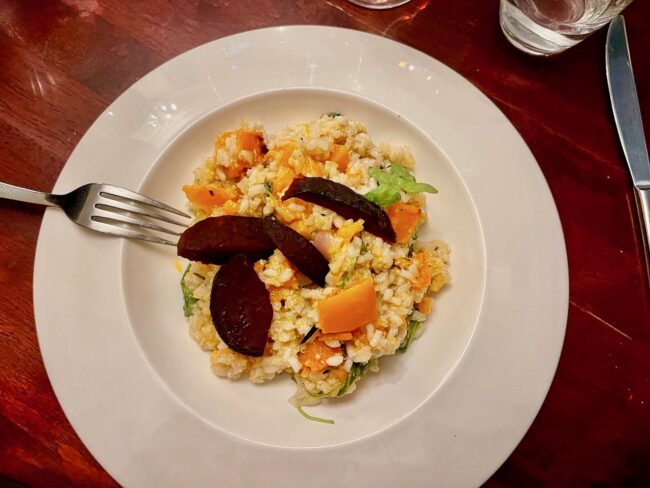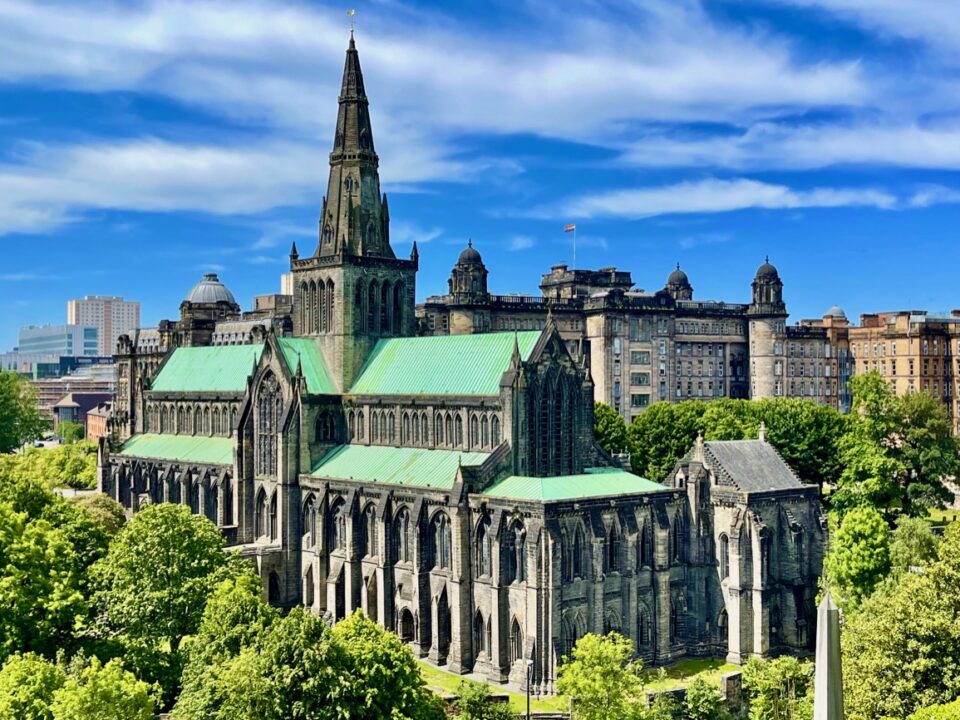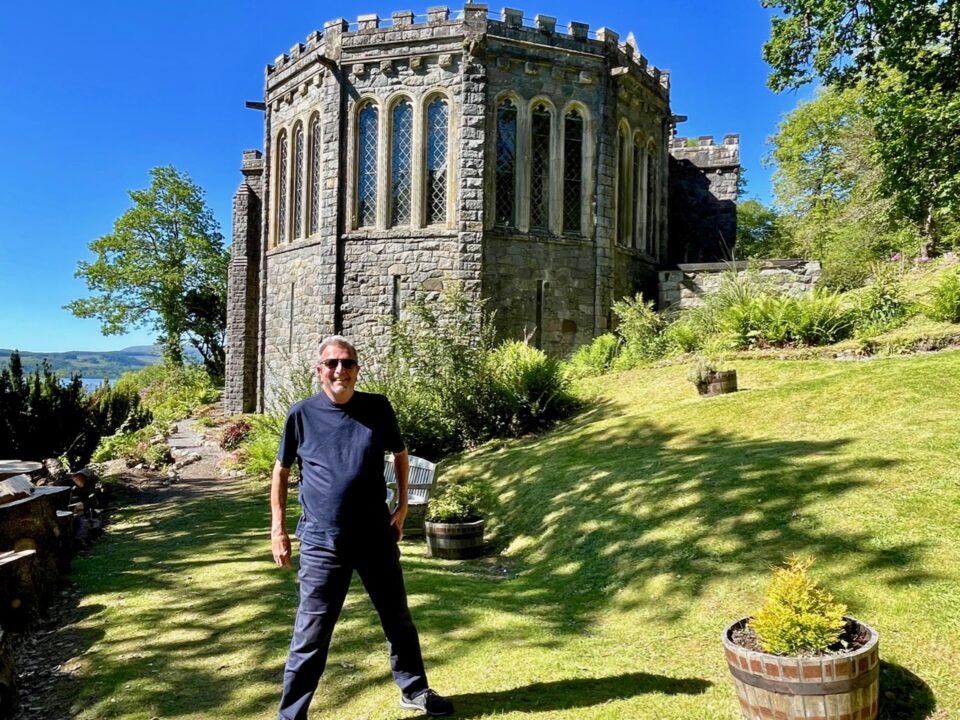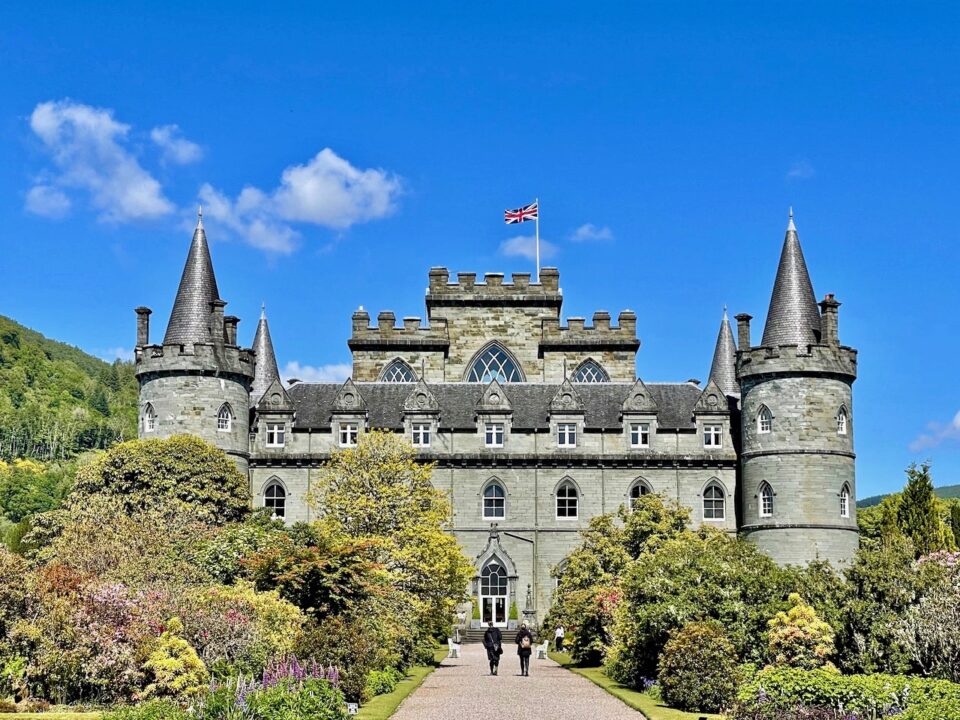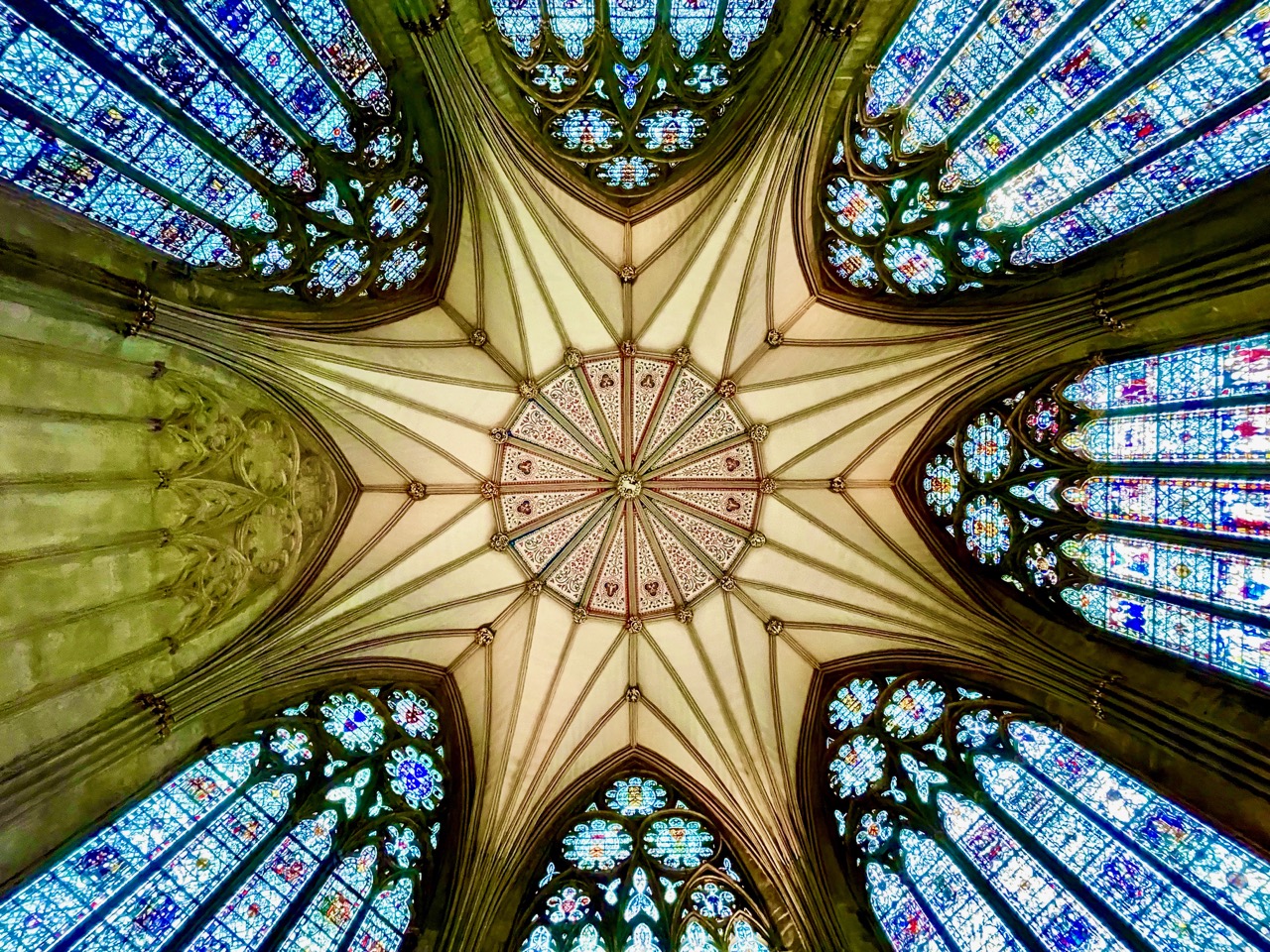
CHAPTER SIX: Final Day In York – Minster, Merchant & Mansion
July 12, 2022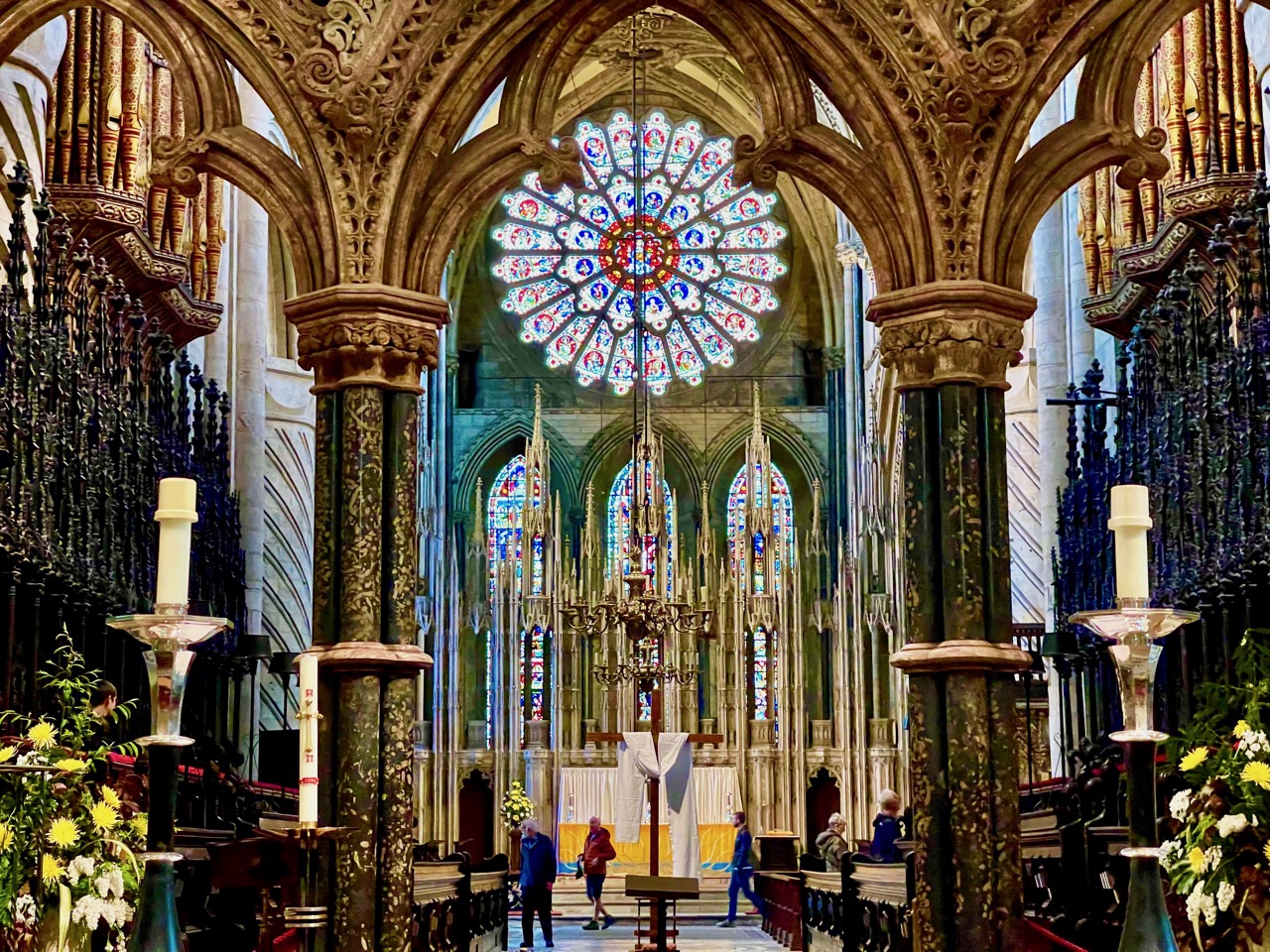
CHAPTER EIGHT: An Unusual Day In Durham
July 21, 2022Surviving Mai Tai Tom’s “Royal” Blunder: 2022 England & Scotland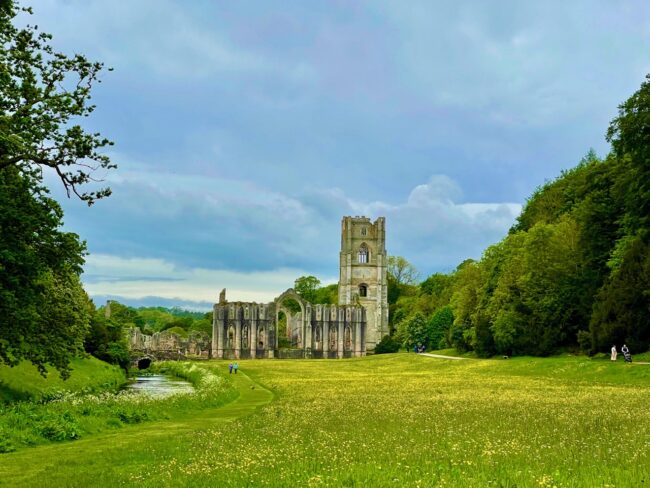
CHAPTER SEVEN: An Abbey For The Ages & On To Durham
Day Seven: Home On The Grange, Dear Abbey, Studley, A Walk In The (Big) Park, Are We There Yet?, Celebrating 1,350 Years, Ready For A Big Night Out, Death Stairs & At Seventeen
One last breakfast at the lovely St. Raphael Guesthouse and it was time to get out of Dodge. After reminding Kim to drive on the other side of the road, we headed out to our first destination of the day, Fountains Abbey & Studley Royal Water Garden, located about 45 minutes from York. It is situated along the valley of the River Skell about two miles west of Ripon.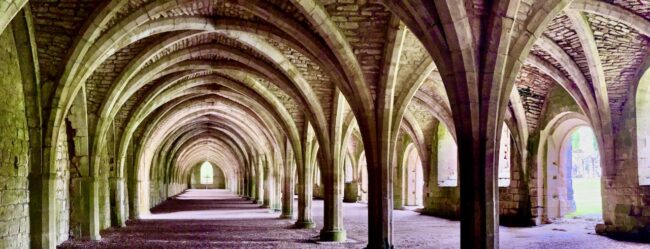
We got to punch our UNESCO Card (I still contend there should be one) because the entire area has status as a World Heritage site because of the ”harmonious whole of buildings, gardens and landscapes.” The property encompasses 800 acres, and although we obviously did not see all of it, what we did explore was pretty spectacular. Purchase your tickets at the Visitors Center.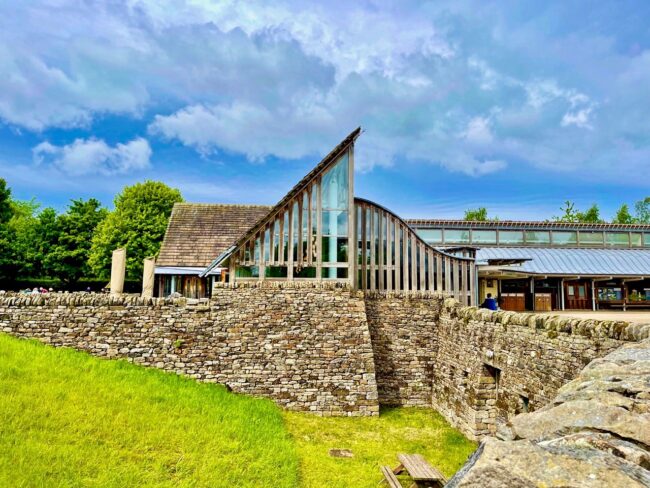
We grabbed a couple of lattes in the cafeteria before setting out to explore the area. We were slightly behind schedule because somehow Tracy found the garden center that was selling David Austin English roses and other flowers she coveted. We weeded her out of there before she could get her wallet out.
How did they know I was coming?
As we headed for Fountains Hall in the distance …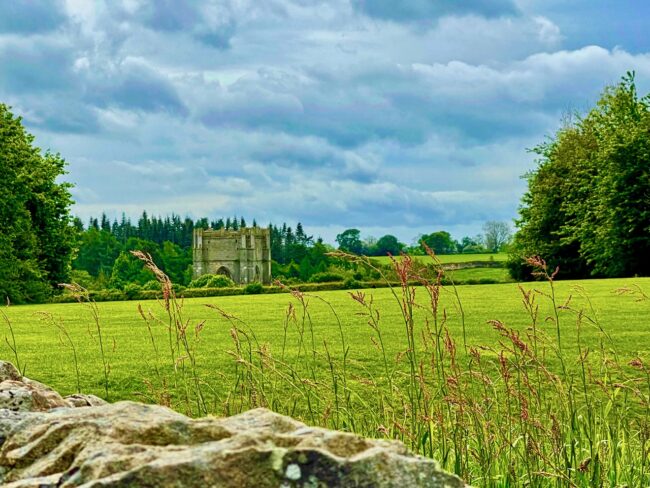
… we made a quick stop at Swanley Grange.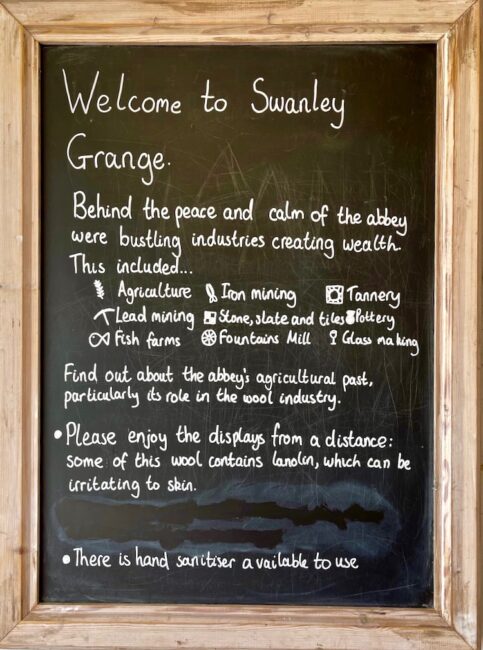
Swanley Grange was one of three monastic farms near the abbey that provided food for the monks, while the wool from their sheep generated an income. During its heyday, the abbey was one of the “largest and wealthiest monasteries in the country.” As you can see, we were already dyed-in-the-wool fans of the property.
We also took a look at the vegetable garden, which you can explore for as long as you’d like. Visitors can even try weaving and knitting.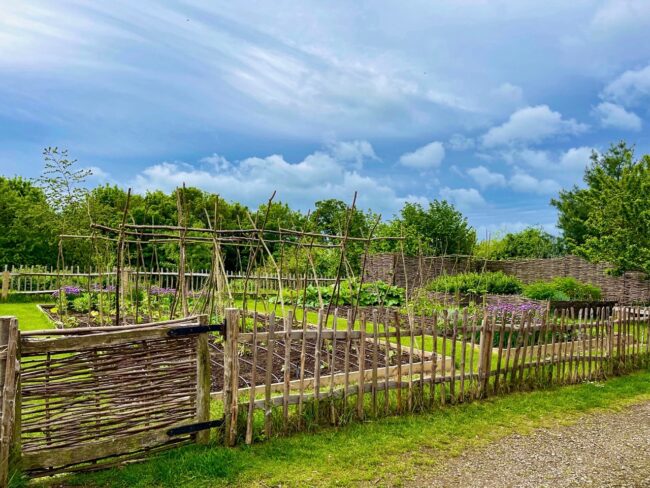
Considering all the weaving I’d done on our walks through York, we pressed on toward Fountains Hall. Although a tad on the chilly side, the walk was as refreshing as it was beautiful.
Fountains Hall was constructed as a Jacobean country home built into a hillside at the end of the 16th century. The builder, the not-so-popular Stephen Proctor, used stones he stole from the abbey ruins. It was utilized, among other things, as a courthouse and a stately home through the centuries and was neglected for quite some time until it was renovated between 1928 and 1931 by Commander Clare and Lady Doris Vyner. We discovered the Duke and Duchess of York (later King George VI and the Queen Mum) were often guests of Lady Vyner.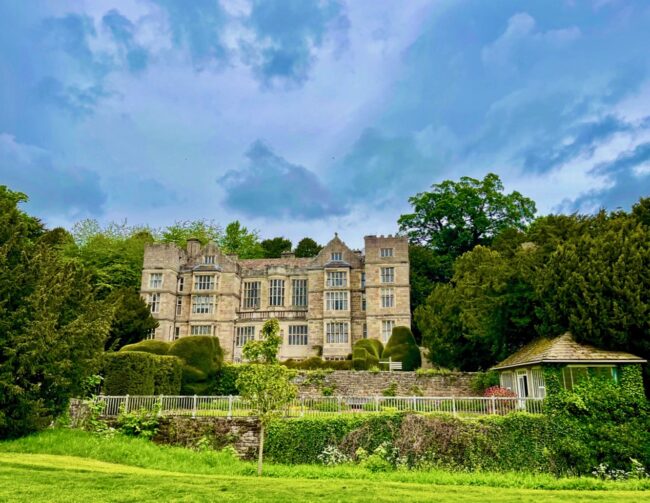
Inside one of the rooms was a wall of woolen socks. Why? During the Great Depression Commander Vyner “built a training camp on the fields above Fountains Abbey” that could house 36 young men, who would receive guidance in fields ranging from gardening to forestry to domestic service, in order help them get back on their feet and pursue jobs. The socks have the names of the boys, and there is also an interactive tablet next to the socks that tells stories about the boys. The wall hanging is above the fireplace.
The memorial that is seen as you exit the home is one that the Vyners erected for their son and daughter, who both perished at a young age. Their daughter passed away at the age of 18 in 1942 from sleeping sickness, while their son Charles, a pilot in the Royal Naval Reserve, was classified as missing in action when the plane he was flying crashed in the sea off Rangoon on May 5, 1945. His parents were not notified of his disappearance until four days after VE Day.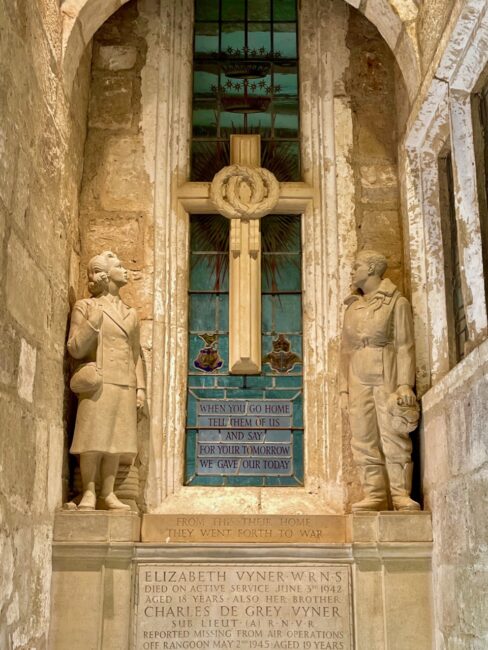
After that sobering story, we stepped back outside into the lush beauty of the countryside …
… where each couple took the obligatory bridge photos that might be used in their respective Christmas cards.
Words like verdant and bucolic came to mind as we walked toward Fountains Mill. Living in Southern California, those words don’t pop into my head very often.
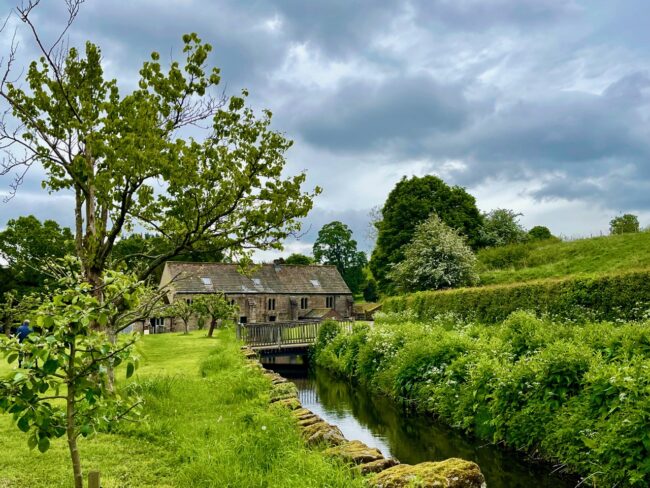 The sundial was not getting a big workout on this cloudy day. Next stop on our epic journey through Studley Royal Park was Fountains Mill, the oldest building on the entire estate. The 12th-century Cistercian Mill was in use until 1927. It had been used to grind grain for the monastery.
The sundial was not getting a big workout on this cloudy day. Next stop on our epic journey through Studley Royal Park was Fountains Mill, the oldest building on the entire estate. The 12th-century Cistercian Mill was in use until 1927. It had been used to grind grain for the monastery.
How did Tracy sneak in these flower photos????
Our peaceful morning quiet was suddenly shattered by a young man who knew the ropes and started ringing the bell … often. Sufficiently hearing deprived, we evacuated the immediate area.
I looked at my phone (remember when we wore watches?) and realized we’d been walking for more than an hour, and still no sight of the abbey. I mentioned this to Tracy, and she replied, “It would help if you turned around.” There, in the distance, it stood.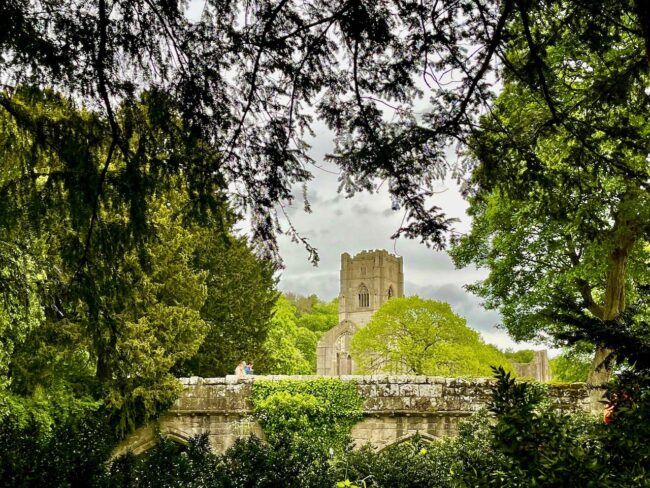
Crossing the bridge we got our first real glimpse of Fountains Abbey. Wow, indeed! And it would only get better.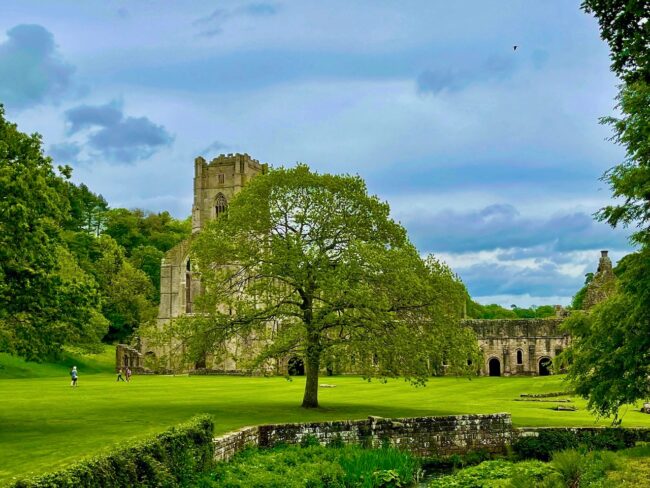
Fountains Abbey was established as a Benedictine Abbey in 1132 and then the next year was turned into a Cistercian Abbey. They are the “largest monastic ruins in the country.” As we admired the ruins, kids were playing and dogs were frolicking. As we’d find out everywhere we went, they love their pooches in Great Britain.
The abbey lasted until 1539 when it was taken over by Henry VIII who had it dissolved along with so many other monasteries.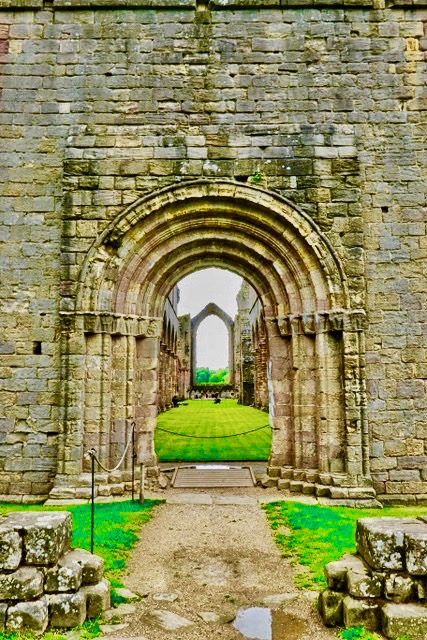
There are many photographic opportunities, but perhaps none better than the Cellarium, which stretches more than 300 feet.
Food, wine and ale for the monks were stored in this cool and dark area. 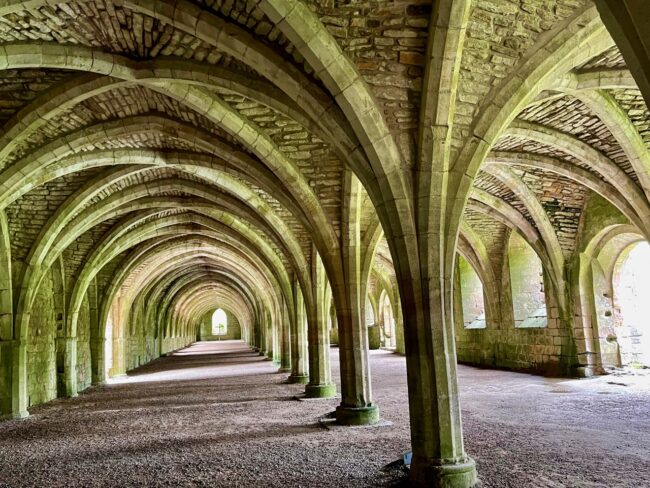
You could take a thousand photos here. Wait, I think we did.
A striking part of the Abbey is the nave.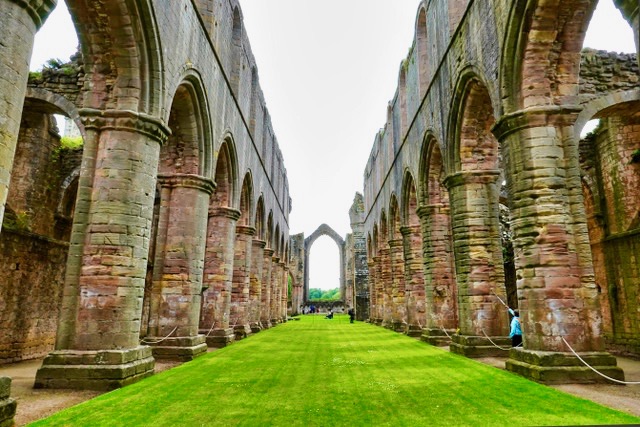
It looks down toward the ‘Crossing.’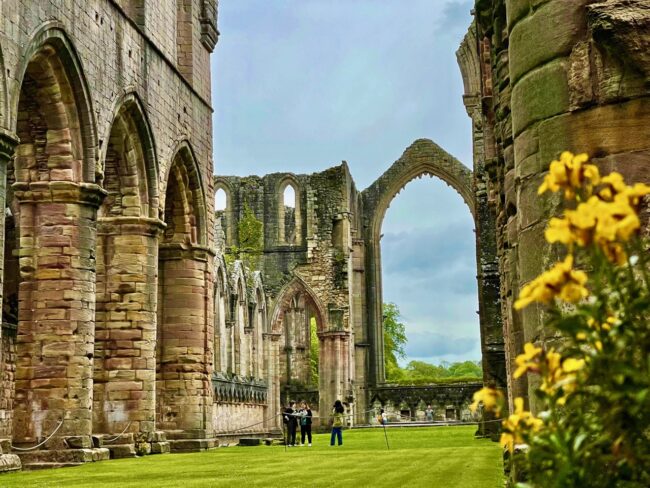
Here’s an ancient relic wearing a coat in front of the nave.
The Chapel Of Nine Altars, built in 1280 is at the end of the nave.
Fountains Abbey ranked at the top of all the sights we visited on our three-week journey through England and Scotland.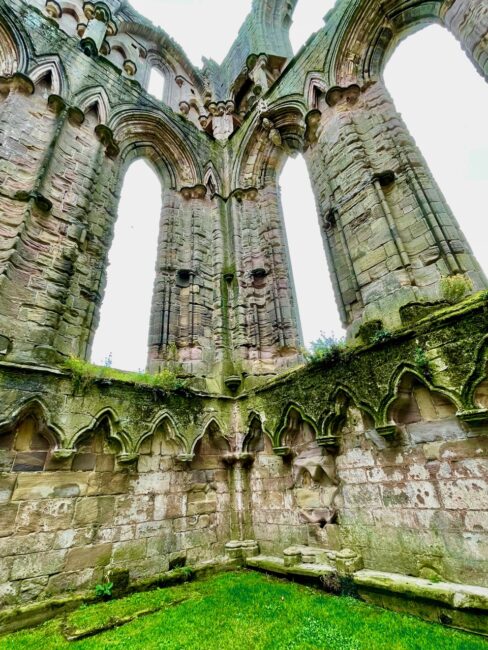
No matter which end of the abbey you were situated, you felt in awe.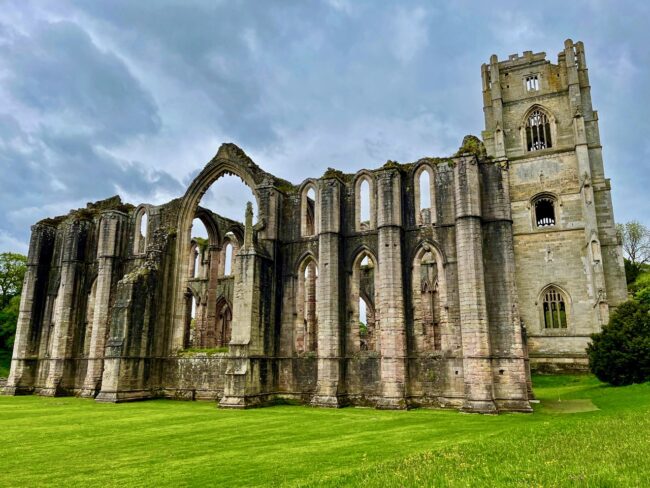
And the setting … just wonderful.
We spent a long time enjoying the abbey, but there was still quite a walk left in front of us as we headed along the river to the water garden at Studley Royal Park. 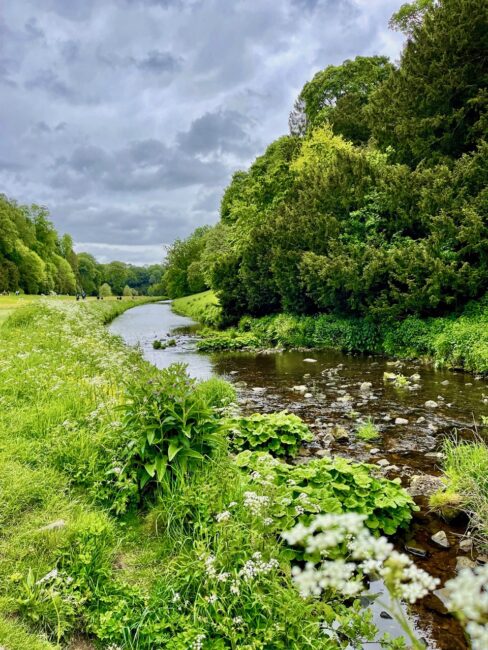
“The water garden at Studley Royal created by John Aislabie in 1718 is one of the best surviving examples of a Georgian water garden in England.” We walked along the Upper Canal. I wish we could have spent a longer amount of time here, but by the time we’d visited the abbey, we were now a little more than two hours into our walk. In the distance we saw the Moon Pond and up on the hill, we spied the top of the Octagon Tower.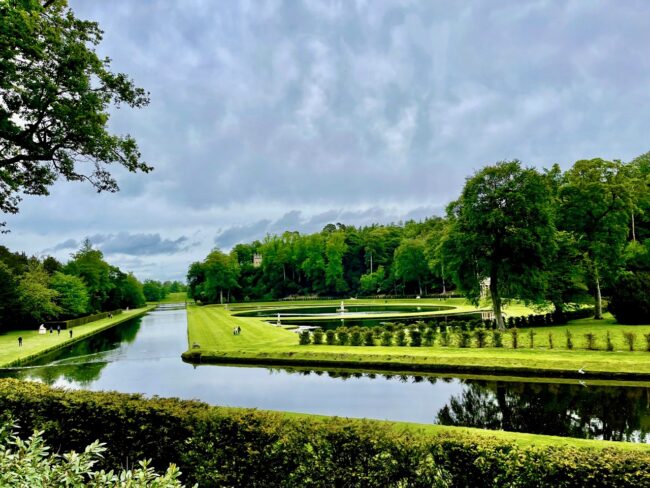
In the middle of the Moon Pond is the statue of our friend Neptune, who we have met at various cities throughout Europe, although depending on the country, sometimes he goes by his other name, Poseidon.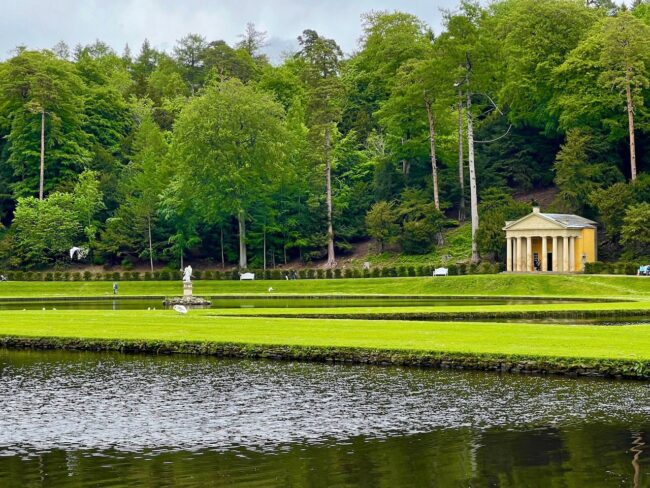
Behind the pond is the Temple of Piety, which was originally constructed as a building dedicated to Hercules.
This guy had a bird’s eye view of the small waterfall.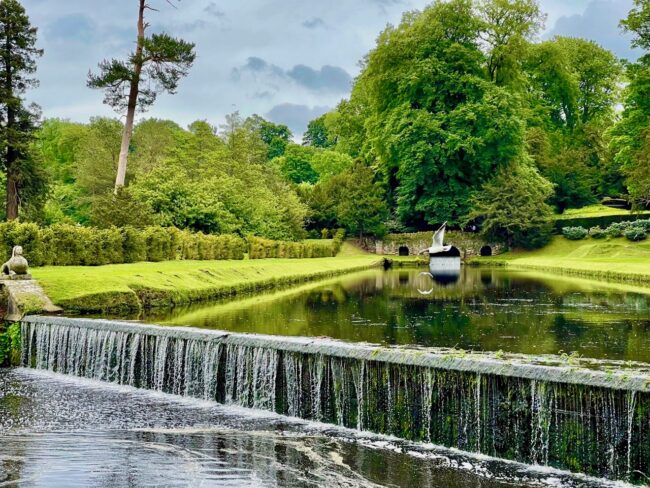
By now, we were searching for the quickest way out. Someone told us of a “shortcut” to the parking lot. I’d hate to see the “longcut.” We climbed up a steep hill and eventually we were in part of the Studley Royal Deer Park. As we found out on this trip, deer seem to be elusive in Great Britain, even though there was supposedly more than 300 deer roaming about. Sadly, there were none to fawn over. But, lo and behold, much to our group’s amazement there was another church. I had told them there were less churches on this trip, but by now they knew I was lying, because in front of us stood St. Mary’s Church.
This church was build in the memory of Frederick Vyner, who was murdered in Greece in 1870 after being kidnapped. His mother and sister used the ransom money they never had to pay to build this church.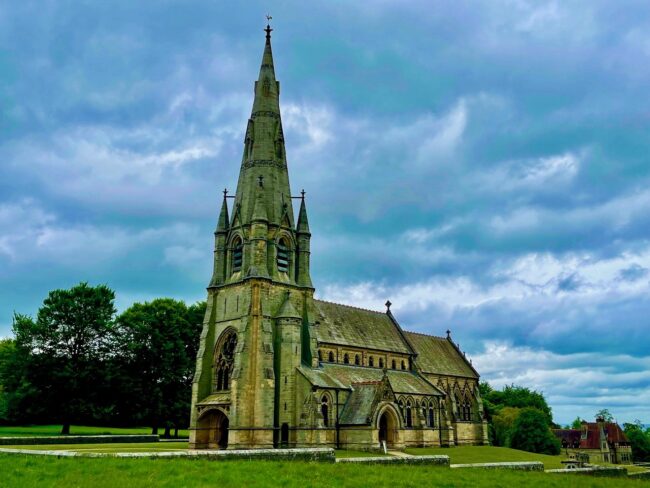
It was constructed near an obelisk that was put up in 1805.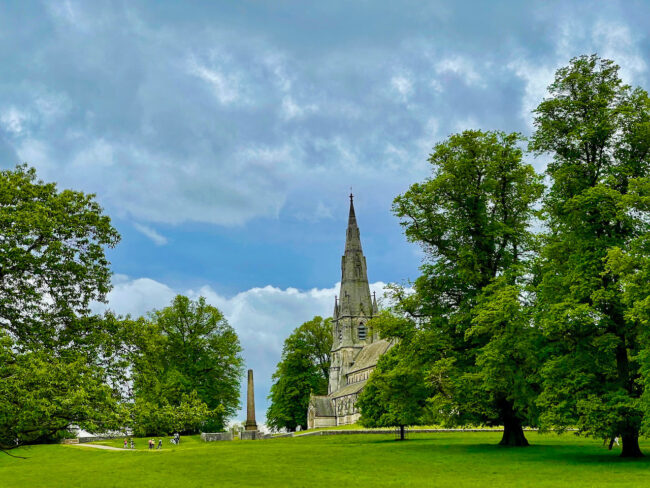
Luckily for me, the interior of this Victorian church is quite lovely. The Roof Of Heaven supposedly depicts the end of times, which coincidentally we were nearly coming to end of times on the property before we moved on.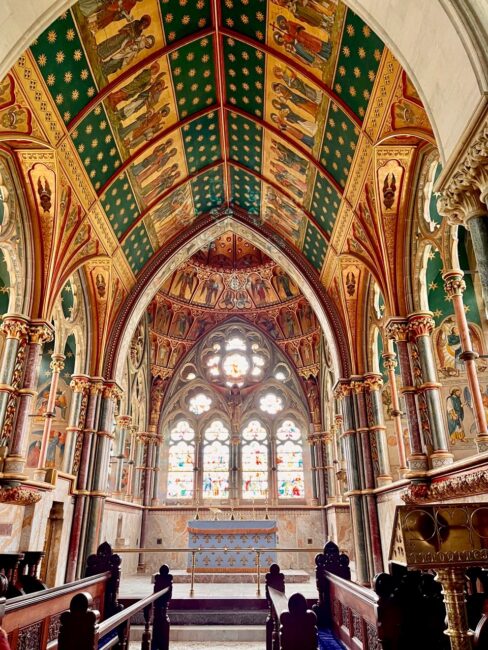
The stained glass is vibrant as are the multi-colored marble columns.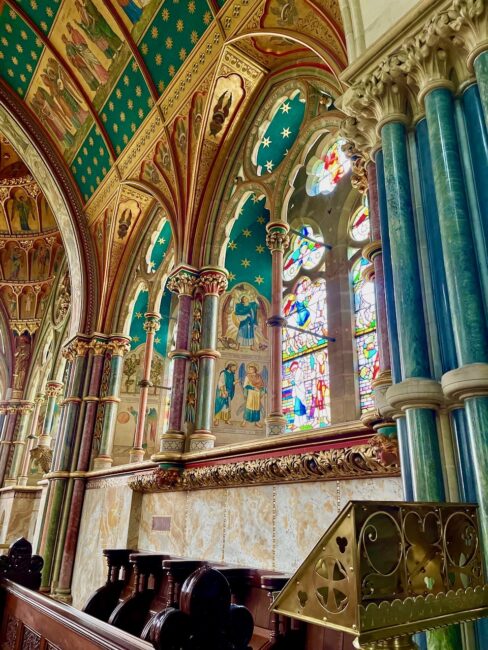
There are also effigies of Lord and Lady Ripon.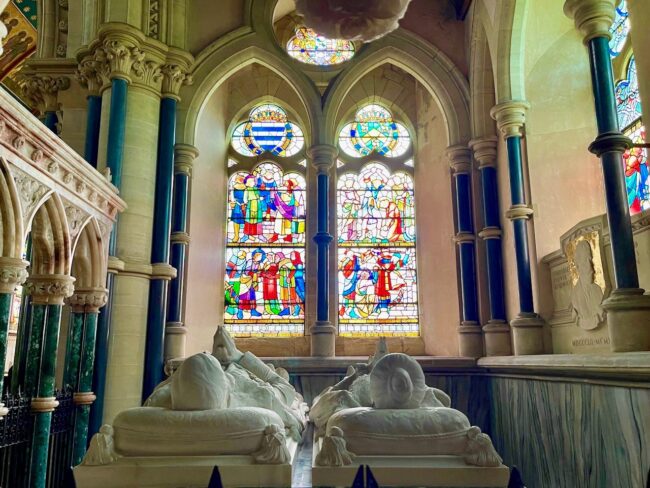
Next door to St. Mary’s in the Studley Royal Deer Park is the Chorister’s House, built in 1873 as a music school and residence for the organist.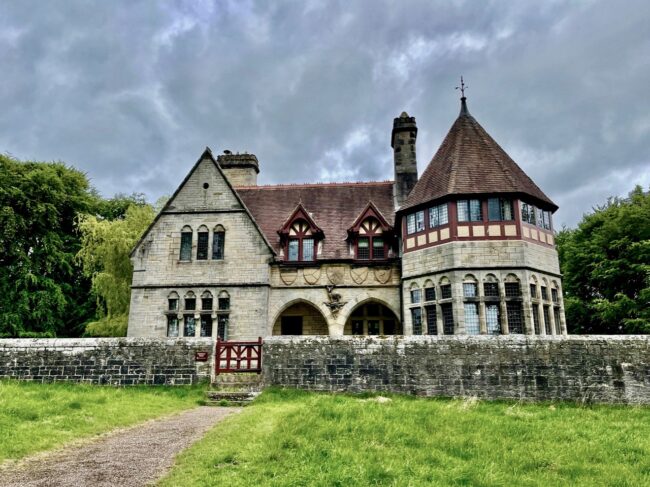
We were finally on our way. Mary said, “I thought you said there were less churches on this trip. Where do we go next?” Very quietly I whispered, “Ripon Cathedral.” After a quick lunch in nearby Ripon, we ambled toward the cathedral. As we walked, I remarked to Mary, “Just think, we won’t see another cathedral on this trip until tomorrow.” I couldn’t tell what Mary was praying for as we entered the cathedral.
Ripon Cathedral is all about St. Wilfrid, who founded the first church here in 872. This year (2022), the cathedral celebrates the 1,350th anniversary of its dedication.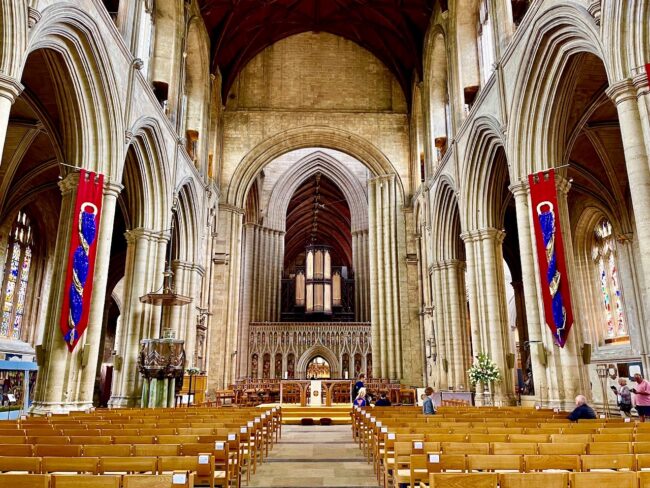
Not to be outdone by the many other cathedrals we visited on this trip (shh, don’t tell Mary, there are a couple of more), Ripon Cathedral’s crypt is the oldest surviving structure of any cathedral in England, and actually predates the country by more than 250 years. Fortunately for the crew, the crypt was not open on this day, so we spent some time viewing the interior of the cathedral.
The big ticket item here is the Choir Screen. There are eight painted kings (sorry to the two kings we left out) along with 24 other statues. The original screen, which has been restored, is thought to date back to 1494.
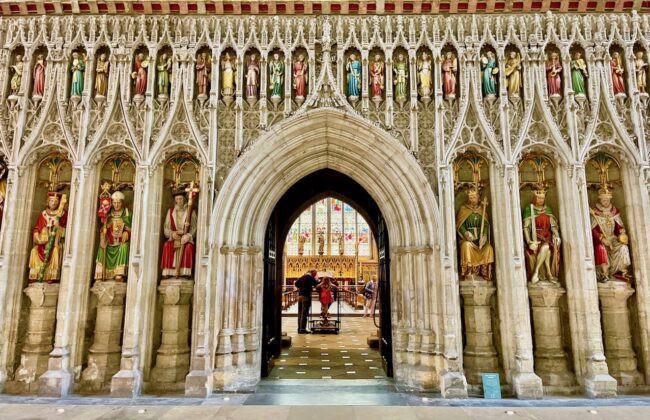
The statues are of people who played an integral role in the cathedral’s past.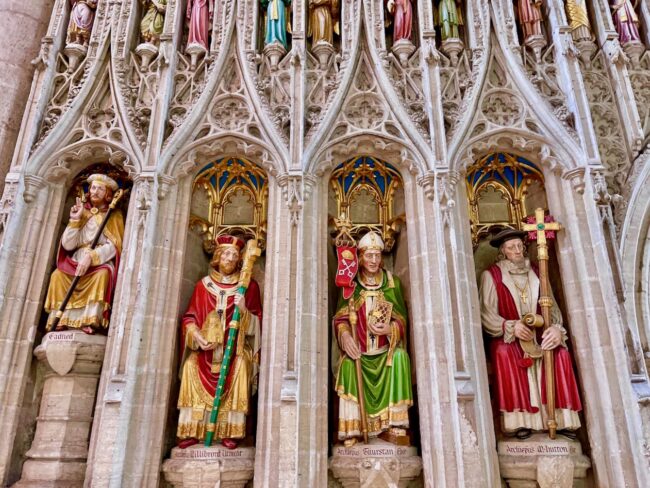
On the other side of the screen is the choir.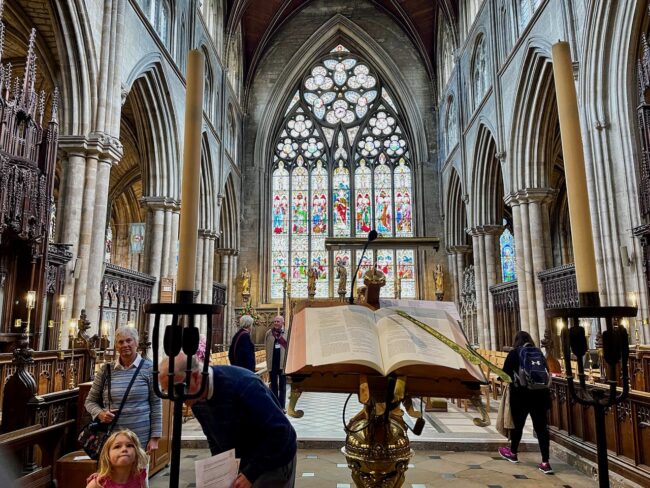
Every window tells a story.
Finally, we paid homage to St. Wilfrid in the aptly name Wilfrid Chapel. Scenes representing his life are in the stained glass window. Upon his death in 709, it’s said a “miraculous moonbow” appeared over Ripon.
We walked by Ripon’s beautiful town hall, and it was on the road to Durham. I think that bird is following us.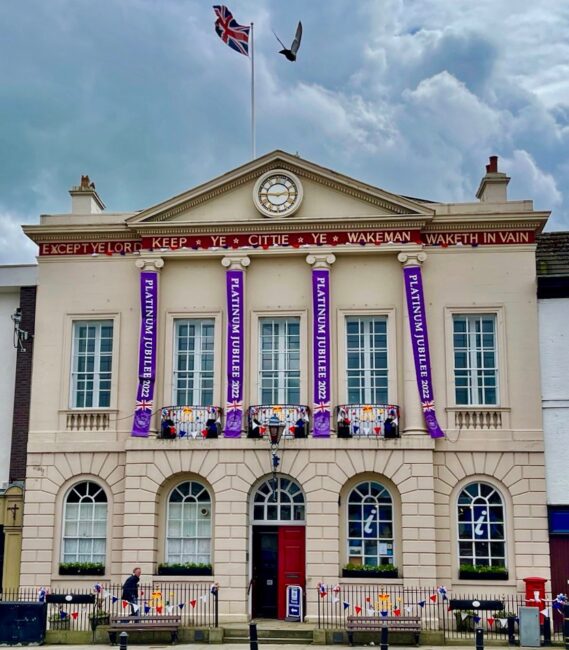 I had hoped to go to Barnard Castle on the way to Durham, but unfortunately I found out before we left that some couple had the audacity to get married there on this day, thus scuttling my plans. We arrived in Durham late Saturday afternoon, and found our lodging for the following two nights, the Hotel Indigo, whose building has an interesting history. It is the Old Shire Hall building, which from 1868 to 1963 served as the headquarters of the Durham City Council. Since I had debated about staying here, this seemed like the perfect choice.
I had hoped to go to Barnard Castle on the way to Durham, but unfortunately I found out before we left that some couple had the audacity to get married there on this day, thus scuttling my plans. We arrived in Durham late Saturday afternoon, and found our lodging for the following two nights, the Hotel Indigo, whose building has an interesting history. It is the Old Shire Hall building, which from 1868 to 1963 served as the headquarters of the Durham City Council. Since I had debated about staying here, this seemed like the perfect choice.
Early in the evening, Tracy and I walked the short distance over the historic medieval Elvet Bridge into town, which was bustling with college students ready to celebrate Saturday night. Some seemed to have gotten a head start. We looked down at some boats that would play a part in our walk tomorrow.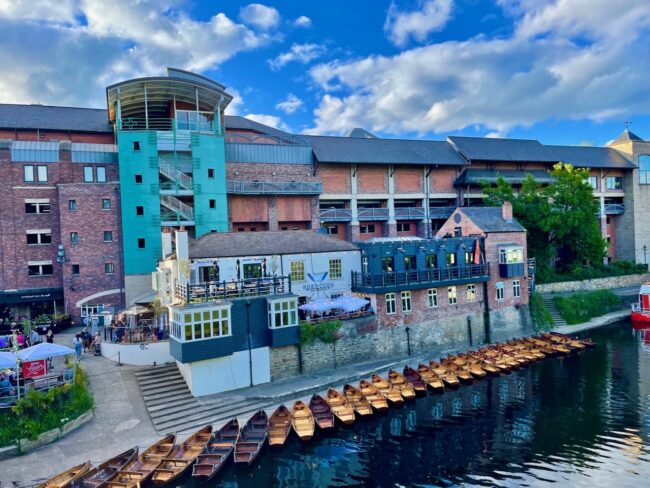
We passed by some cute shops selling Queen Elizabeth Platinum Jubilee souvenirs and eateries that were already getting jam packed.
In the heart of Durham stands a statue of the Marquess of Londonderry, who served with the Duke of Wellington. Thanks to the folks at Atlas Obscura, we have this fun story. “After the unveiling, a strange legend became associated with the statue. According to the myth, the sculptor (Raphael) Monti—apparently a bit of an egomaniac—said he would give a reward to anyone who could find even the tiniest error in his flawless statue. No one could, until a blind man asked to be lifted up to inspect the statue with his hands. Suddenly, he declared an error: the horse had no tongue. The legend goes on to say that Monti was so devastated by this humiliation that he ended his own life. The truth is much less dramatic: The horse does have a tongue, and Monti lived until 1881, creating many more statues before his passing.”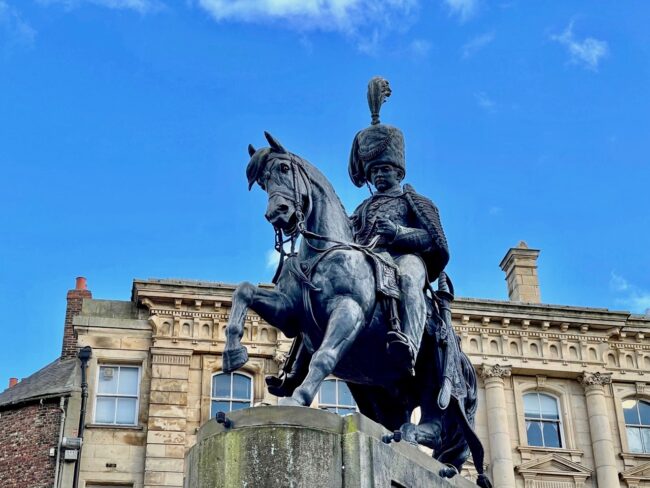
We had reservations for dinner at Restaurant 17 (17 Elvet Bridge), and the stairs leading down to it were a bit daunting at first, especially for some idiot who has a history of falling on his own stairs at home. “Hey, where is everybody? I made it!”
Highlights included Tracy’s beet salad and Pan-seared duck breast with butternut squash purée, roasted beetroot, tender stem broccoli, crispy kale and dark berry jus.
Also good were Mary’s mussels and the Herb Roasted butternut squash and quinoa Risotto.
Although Kim ordered salmon, the waiter came out with pork belly, and since Kim has little or no tastebuds, he said, “No problem.” Afterward he said he could actually taste the dish, and it was good, so it all worked out. I also enjoyed the pork belly with pomme purée, herb roasted carrots, green beans and Cider cream sauce
We then ordered a sticky toffee pudding “for the table.” After I virtually single handedly devoured the dessert, Tracy sarcastically said I should change my name to “Table.”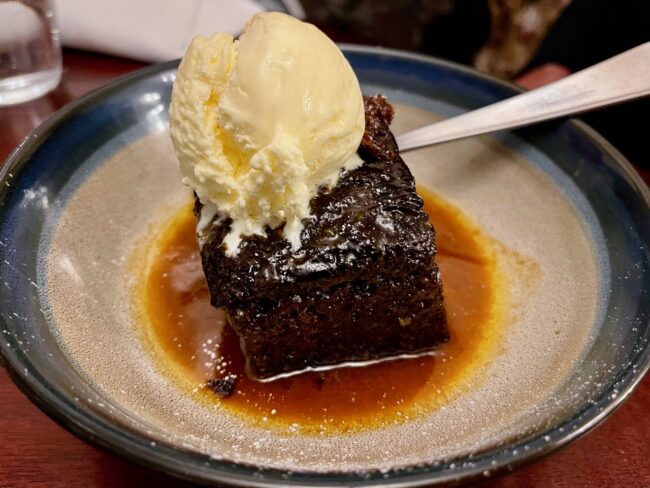
Restaurant 17 might be a little hard to find, but it is certainly worth the effort.
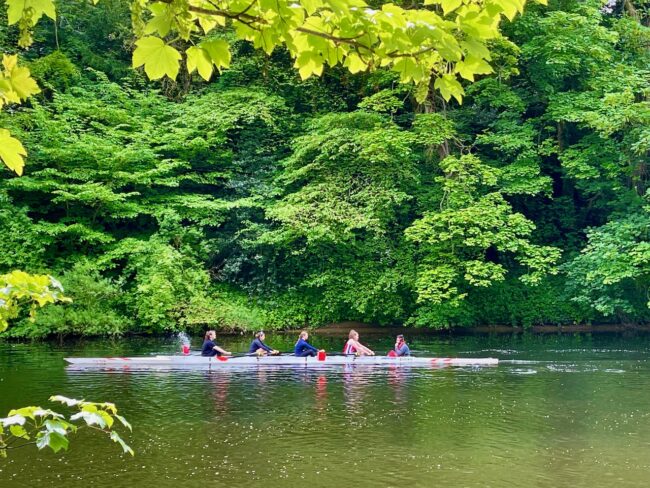 Tomorrow would not be classified as my best day traveling. Although we did take a lovely walk along the river in Durham, visit its historic cathedral and roam a spectacular library, I managed to get myself lost in a most unusual place in the morning and then proceeded to rip my arm off (slight exaggeration) that, for the moment, I thought would end our vacation. Oh, the humanity!
Tomorrow would not be classified as my best day traveling. Although we did take a lovely walk along the river in Durham, visit its historic cathedral and roam a spectacular library, I managed to get myself lost in a most unusual place in the morning and then proceeded to rip my arm off (slight exaggeration) that, for the moment, I thought would end our vacation. Oh, the humanity!
Next: CHAPTER EIGHT: An Unusual Day In Durham
Day Eight: “Excuse Me My Husband Is Lost”, Is That Marcel Marceau?, There’s Got To Be A Morning After, A Sunday Stroll, Row Row Row Your Boat, Tom’s Arm Chair Injury, In Search Of St. Cuthbert, Checking Out The Books In The Library, Is There A Doctor In The House? & The Trip’s In Jeopardy

